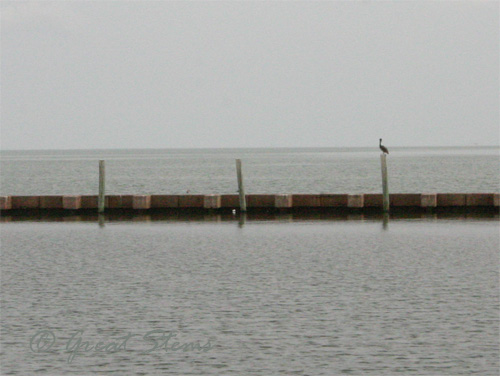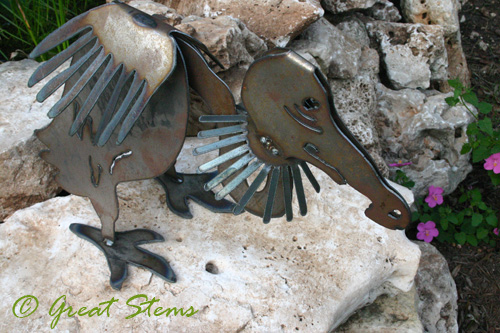What do you get when a bunch of Austin Garden Bloggers get together?
- Beautiful plants to ogle
- Introductions to species you’d never seen or heard of
- Visits to nurseries and gardens you’d never been to
- Lots of chatting with new friends you have so much in common with
- Cameras. Need I say more?
- Celebrations of colors, textures, garden design, hardscape, art, and all things nature
- Stories of plants (identified by scientific name), trips, tours, kids, spouses, gardens, chicken coops, plant-swapping, buggy pests, and decaying dead urban wildlife at lunchtime (oops)
- Cars filled to the brim with newly-purchased plants
- Good times and good food and sometimes a little confusion
 Yesterday many Austin Garden Bloggers gathered for a day trip to Madrone Nursery in San Marcos, San Antonio Botanical Garden, and Antique Rose Emporium.
Yesterday many Austin Garden Bloggers gathered for a day trip to Madrone Nursery in San Marcos, San Antonio Botanical Garden, and Antique Rose Emporium.
Blogs represented were Digging, Sharing Nature’s Garden, Go Away, I’m Gardening!, In Bloom, Great Stems, Shovel-Ready Garden, Garden of E, Rock Rose, Gardener of Good and Evil, Round Rock Morning Glories, Some Like it Hot, and Zanthan Gardens. We were quite the eager plant-loving caravan!
Our first stop was Madrone Nursery, owned by Dan Hosage, Jr. A native plant specialist, he was both enthusiastic and energetic in sharing his love of plants. Many of us bought plants, and I know I’ll need to go back again soon with list in hand for others I’m interested in.
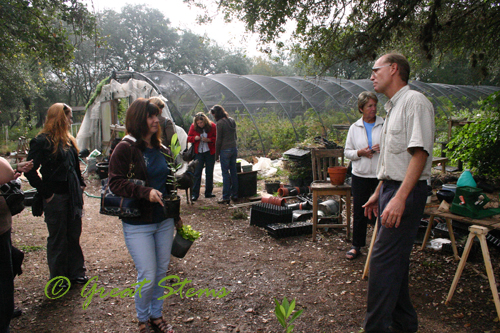
At the San Antonio Botanical Garden, we were greeted by towering century plant blooms.
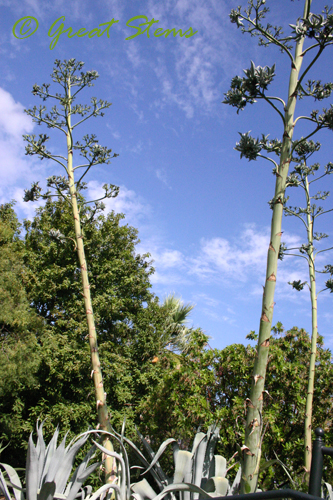
The lime-colored leaves of Duranta “Gold Mound” provided a colorful contrast to the surrounding plants.
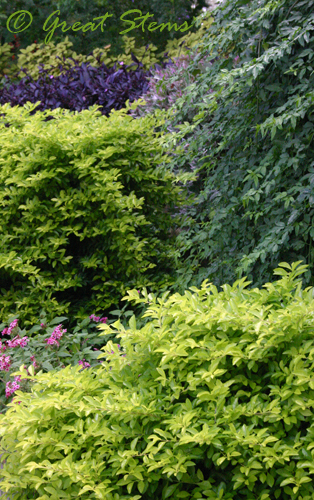
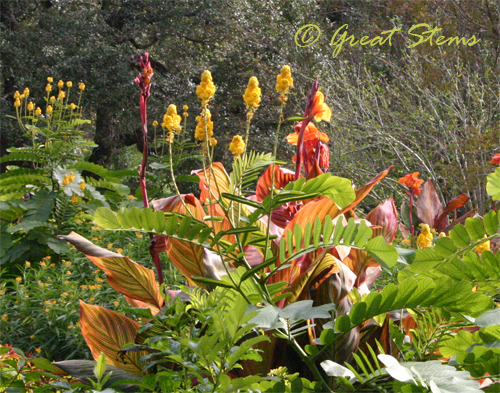
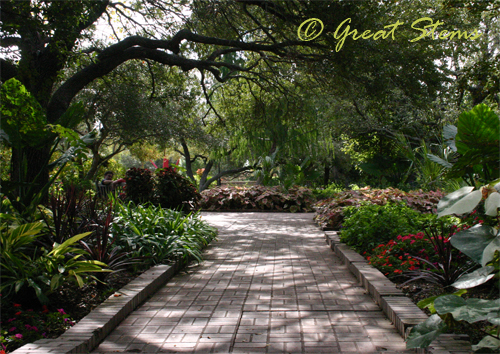
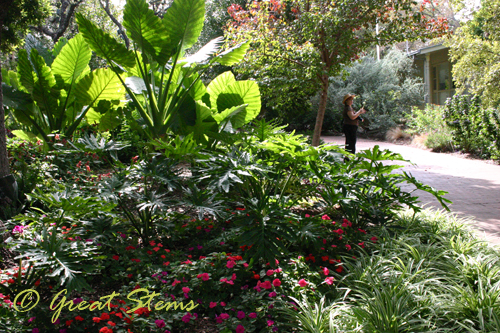
Note regarding many of these plant photos from SABot: I wrote down the names of as many plants as I could, and now I can’t seem to find the sheet of paper I had. Perhaps I left it in Pam’s car? If I can locate the paper, I’ll update this blog with more plant IDs.
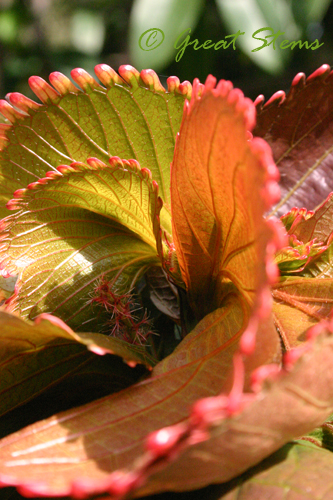 Bird of Paradise
Bird of Paradise
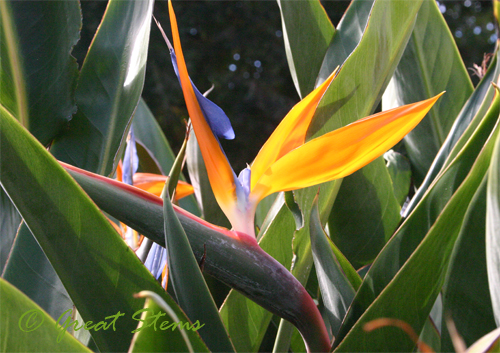
Bee in Datura
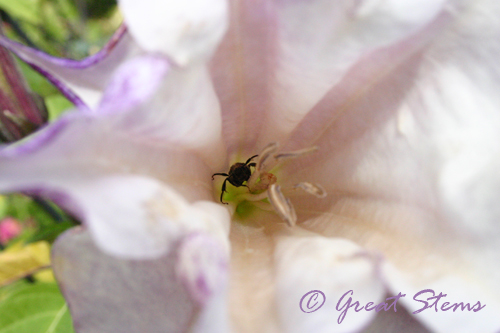
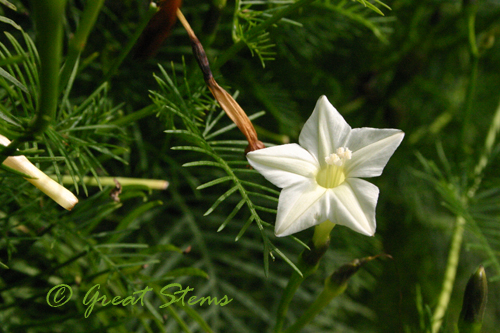
Black Beautyberry
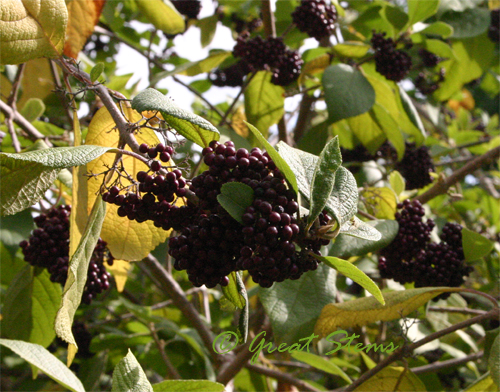
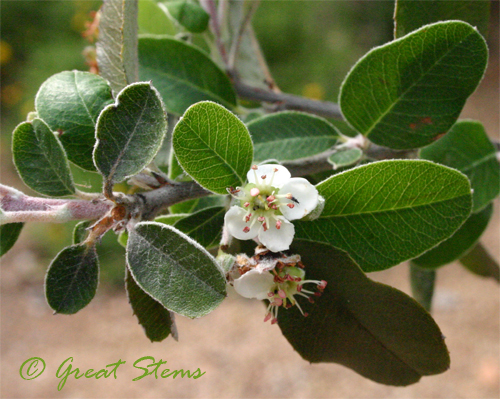
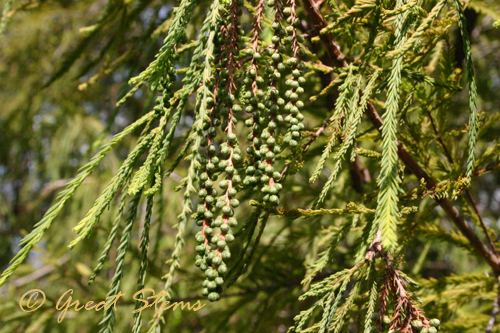
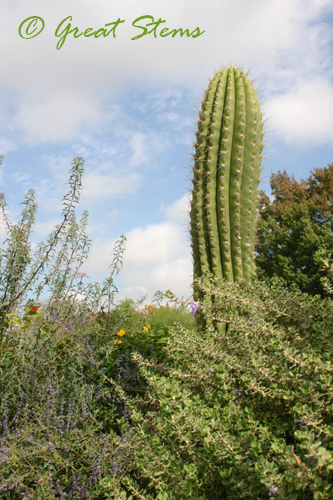
Barbados Cherry, loaded with fruit
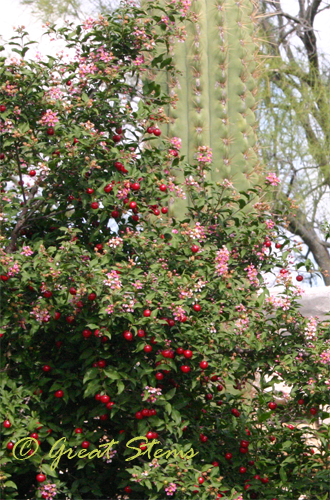
Pacific Chrysanthemums (the lovely white trim on these leaves inspired a few people to take this plant home from Antique Rose Emporium later in the day)
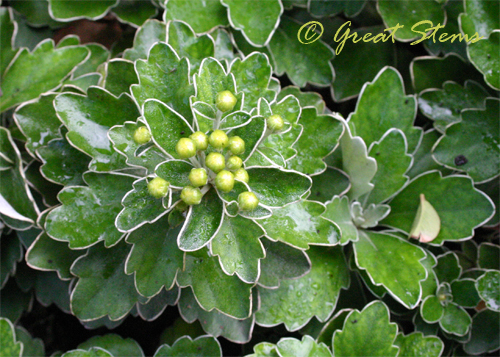
Papyrus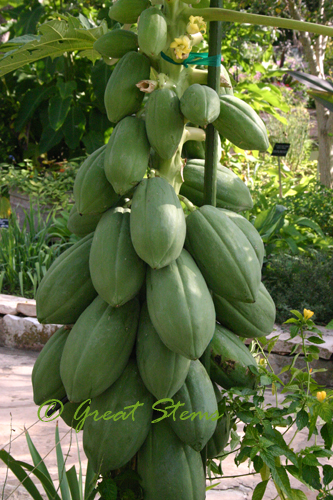
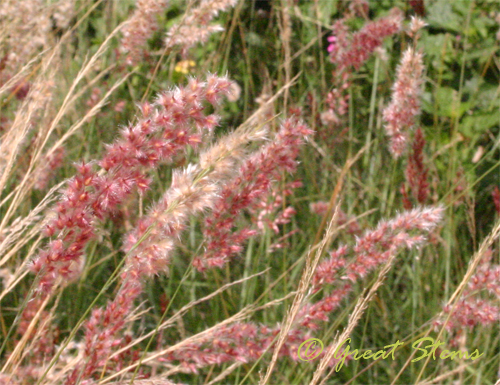
On display throughout the gardens were Dave Rogers’ Big Bugs statues. Apparently these were at the Wildflower in Austin a year or two ago, but as I had never seen them before, I decided to run around to get pictures of all of them. They included a praying mantis, a dragonfly, a line of ants, an assassin bug, a ladybug, a grasshopper, a damselfly, and a giant spider on a web. Hmmm, it’s hard to pick a favorite. It’s hard to resist the spider, though. Guess that makes me a fly.
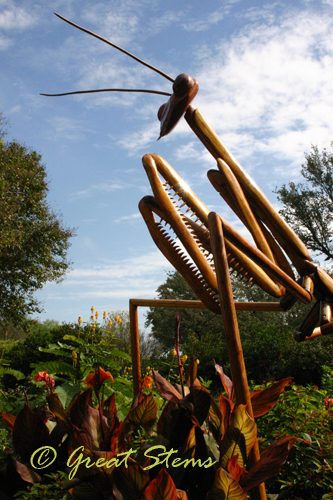
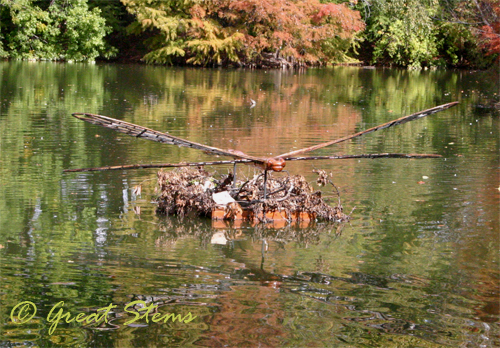
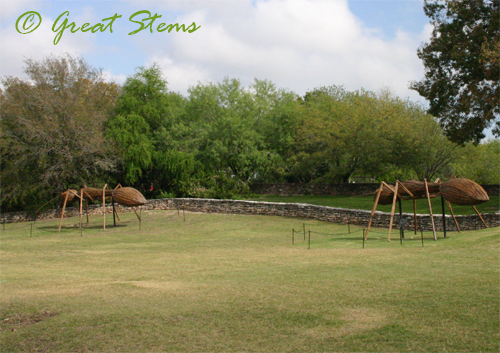
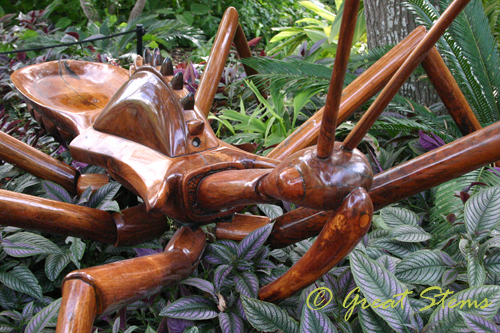
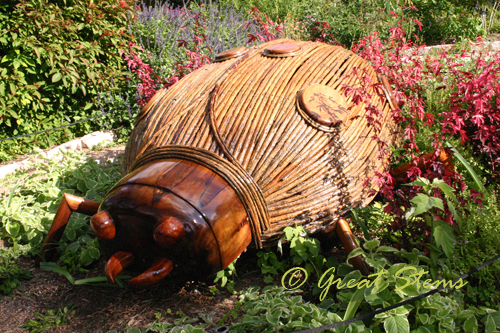
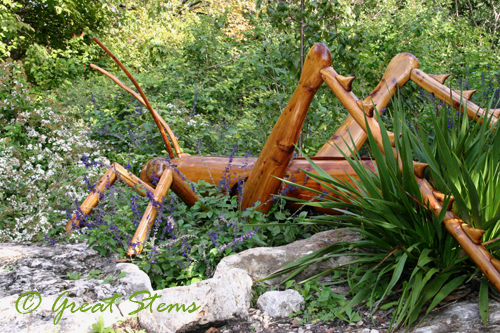

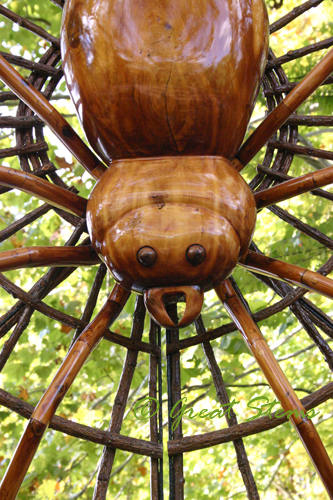
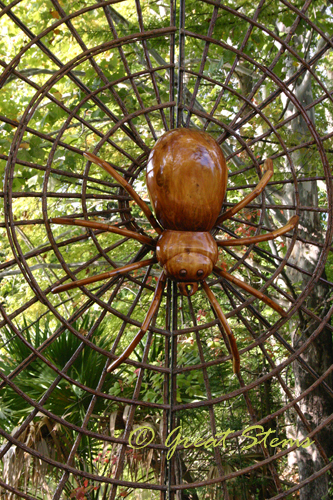
Of course, there was other beautiful art all over, as well. This statue represented different things to different people: a star, a child, a seastar, a Thumbkin, a dancer, and more.
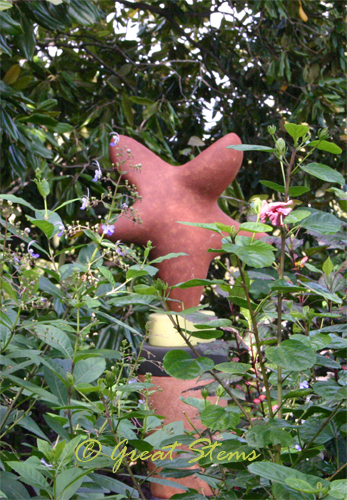
There were hundreds of Monarchs, especially around the pentas. I found it interesting that all the ones I studied were females. Where were the males?
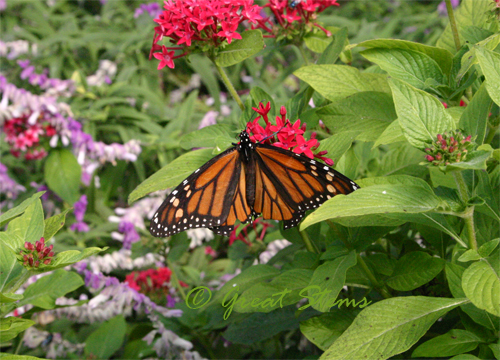
Oddly, the Monarch species dominated most of the gardens. Occasionally I’d see another species, like this Ceraunus Blue (Hemiargus ceraunus).
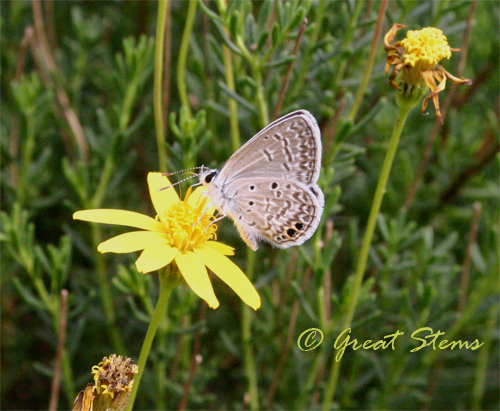
This Bordered Patch butterfly (Chlosyne lacinia), along with a companion, enjoyed a treat of Gregg’s Mistflower nectar by the Auld House.
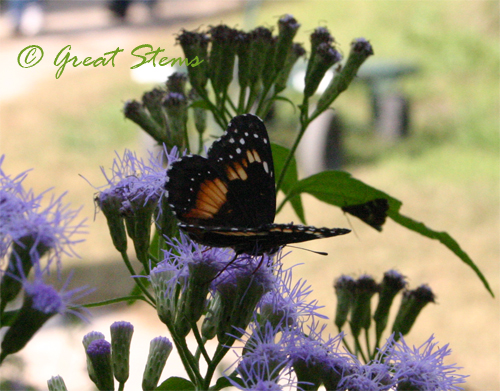
I fell in love with the Children’s Vegetable Garden. These organic plots are maintained by children, and as you can see, they are quite productive. I couldn’t help but admire the very creative scarecrows and other decorations throughout the mini-farm.
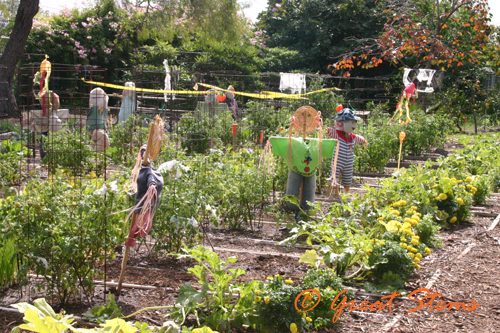
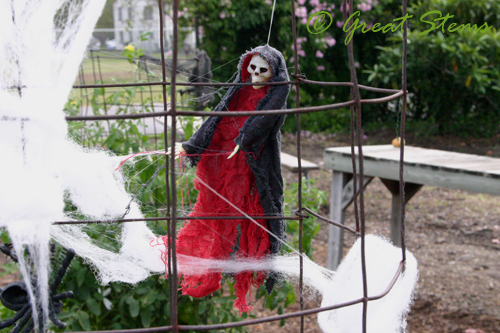

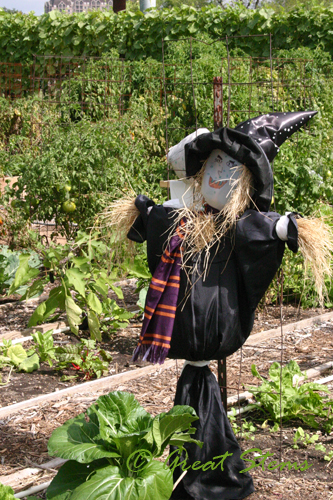
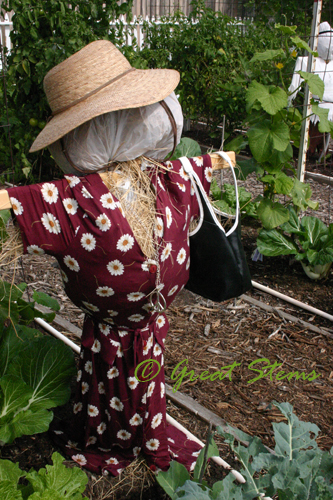
The Japanese Garden seemed a little sad because of its missing tranquil waters. The drought-caused water restrictions in San Antonio forced the shutting off of water features throughout the park.
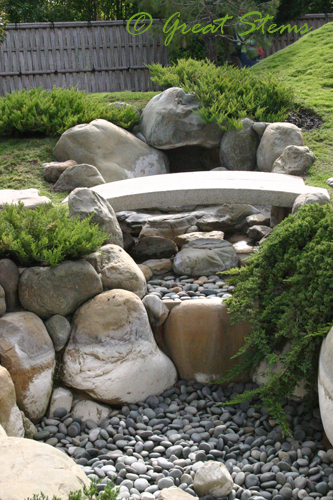 I was wowed by the simple design but elaborate effect of the fence surrounding the Japanese garden.
I was wowed by the simple design but elaborate effect of the fence surrounding the Japanese garden.
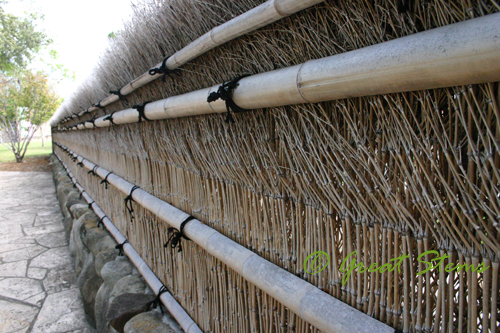 In addition to special exotic areas of SABot, the gardens also had areas focused on different Texas regions, such as South Texas, Hill Country, and this scenic lake setting representative of the East Texas Pineywoods. The reflections on the water were occasionally disturbed by a falling maple leaf or a duck creating a “V” while swimming across the still water.
In addition to special exotic areas of SABot, the gardens also had areas focused on different Texas regions, such as South Texas, Hill Country, and this scenic lake setting representative of the East Texas Pineywoods. The reflections on the water were occasionally disturbed by a falling maple leaf or a duck creating a “V” while swimming across the still water.
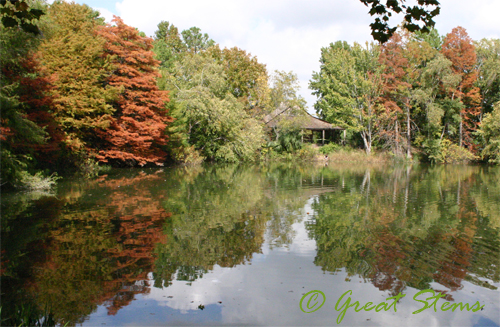
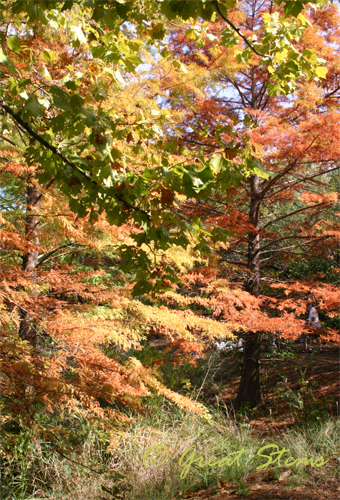
I am always fascinated by the protective spines found on cactus and various succulents.
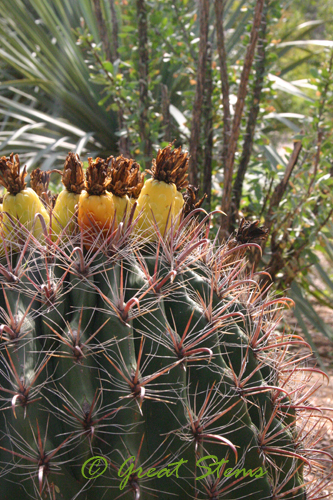
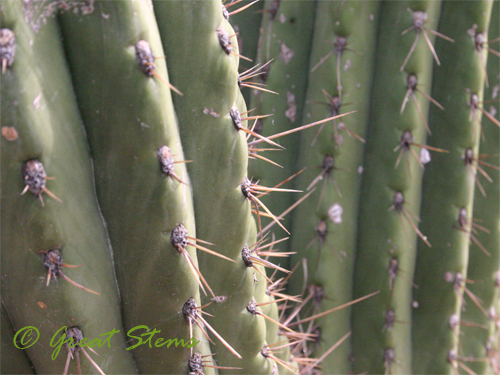
Ocotillo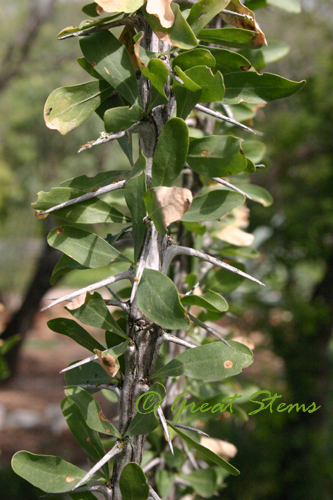
This Dr. Suess-like agave bloom is from a Butterfly Agave.
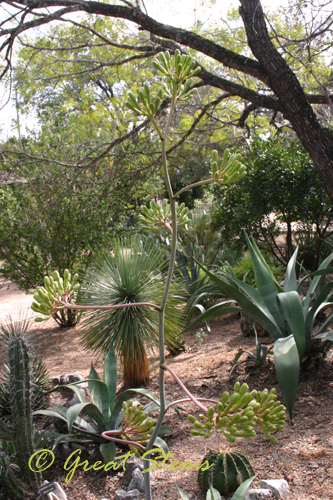
A close-up, and the plant is still delightful.
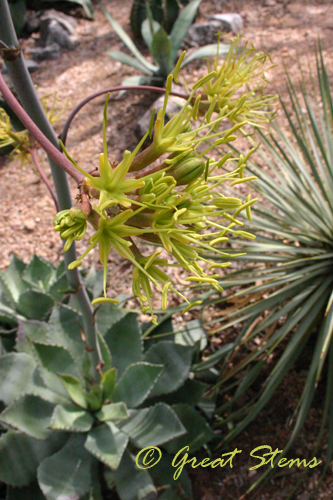
The Sensory Garden was an abundance of textures and scents. Here silver ponyfoot drapes off the sides of a raised garden.
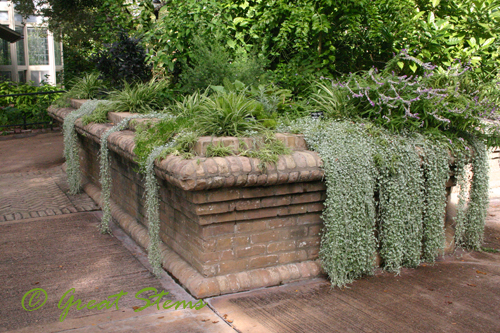 In the same garden, it might be tempting to touch this bumpy plant, but a closer look shows that each bump ends in a tiny and very painful spine. I wondered whether it really should be in a Sensory Garden, then realized that it was just barely kept out of eager hands’ reach. I guess an attempt was made to correct the mistake, if it was one.
In the same garden, it might be tempting to touch this bumpy plant, but a closer look shows that each bump ends in a tiny and very painful spine. I wondered whether it really should be in a Sensory Garden, then realized that it was just barely kept out of eager hands’ reach. I guess an attempt was made to correct the mistake, if it was one.
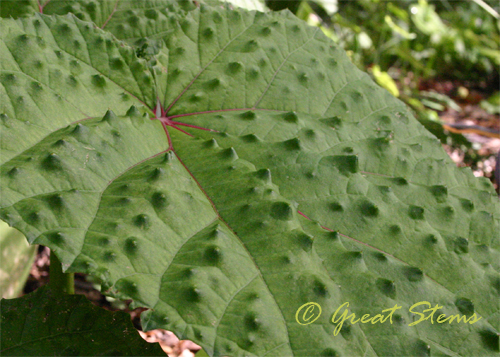
Off in the glass and cement pavilions of the conservancy, we were introduced to a vast collection of unusual plants from different growing regions across the world.
Karoo Cycad (Encephalartos lehmannii)
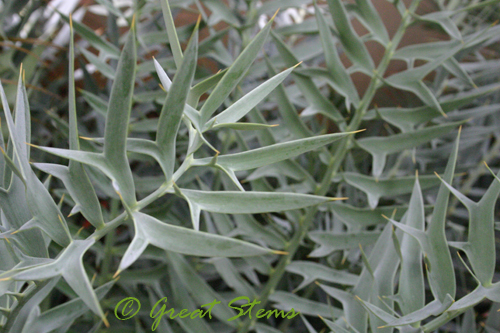
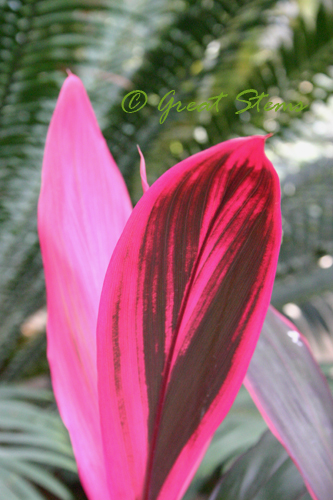
A photographer stops at nothing to get that perfect plant shot!
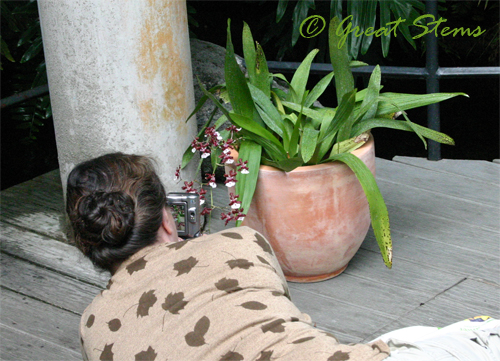
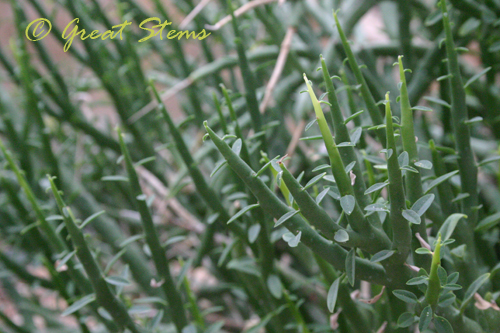
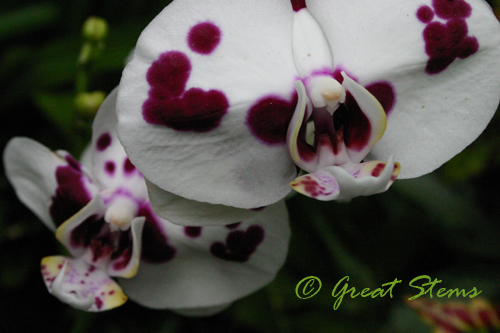
This Christmas plant looks similar to a Poinsettia, but it’s actually a bloom on a large tree.
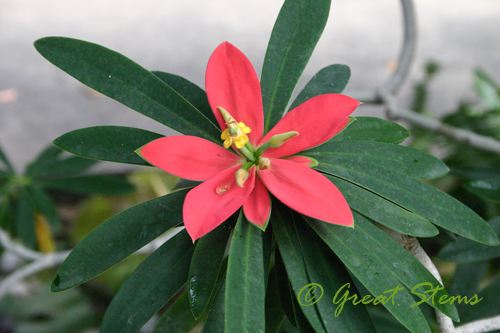
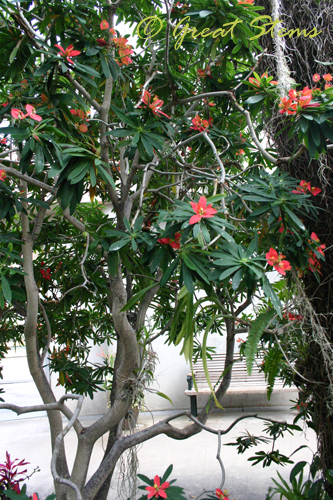
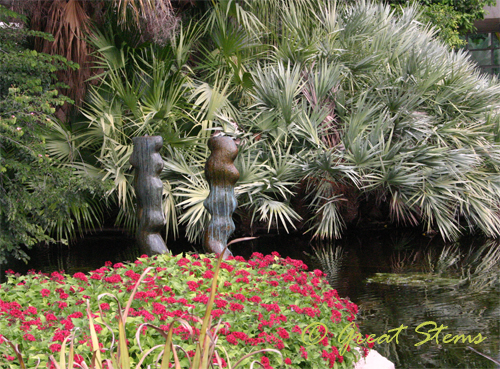
A big black bee visits a Lucky Nut, or Yellow Oleander.
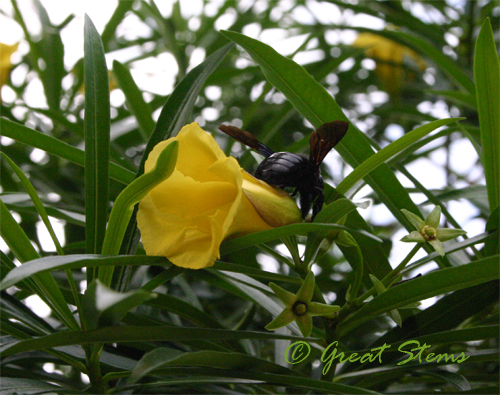
Life-Saver Plant (Huernia confusa) — it’s pretty obvious where this plant got its name!
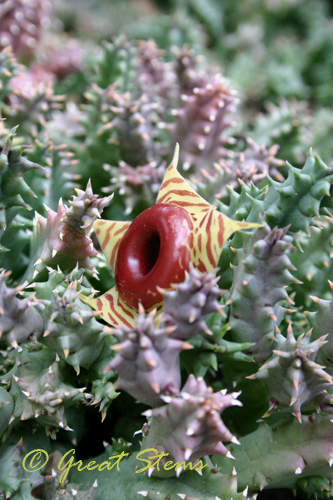 Many of the windows of the glass pavilions had been replaced with boards. It turns out that some of these had been damaged by deliberate gunshots from nearby Sam Houston. I’m quite appalled and upset about this. American soldiers and officers should be role models, not thugs.
Many of the windows of the glass pavilions had been replaced with boards. It turns out that some of these had been damaged by deliberate gunshots from nearby Sam Houston. I’m quite appalled and upset about this. American soldiers and officers should be role models, not thugs.
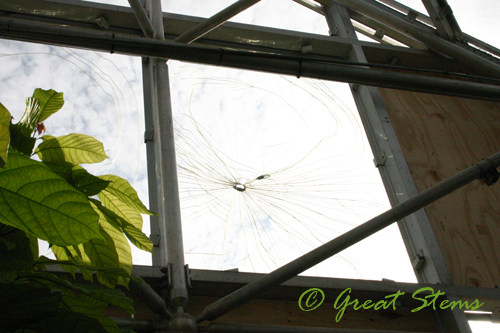
I had great interest in the Watersaver Lane, a series of houses showing a variety of approaches to yards. Tell me, would you choose the sparse, wildlife-unfriendly, and rather unimaginative traditional American yard? (The hint here is, “Please say no!”)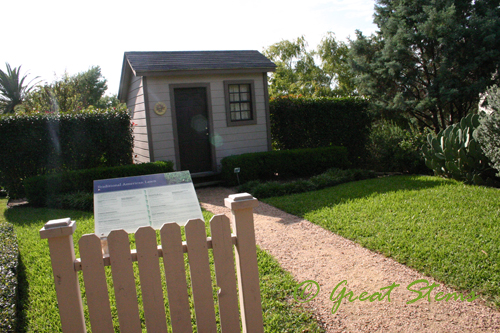 How about a Cottage-Garden style, with reduced lawn and colorful flower beds?
How about a Cottage-Garden style, with reduced lawn and colorful flower beds?
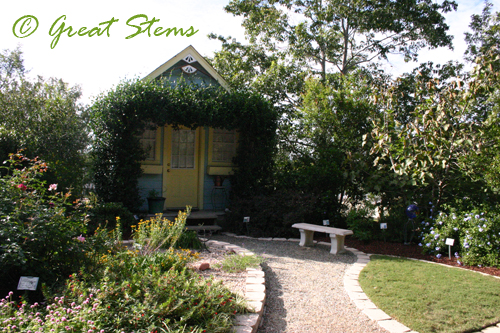 Or a Wildscape Landscape, complete with curvy paths, reduced lawn, and plants selected for their value to birds, butterflies, and other wildlife?
Or a Wildscape Landscape, complete with curvy paths, reduced lawn, and plants selected for their value to birds, butterflies, and other wildlife?
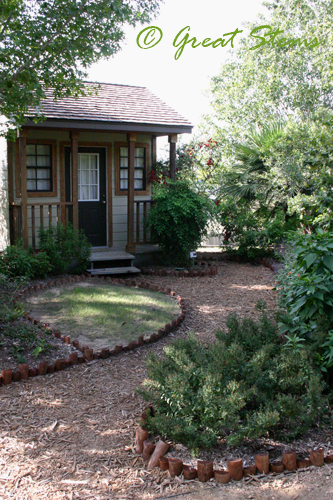 Or do you prefer the style of a Spanish courtyard?
Or do you prefer the style of a Spanish courtyard?
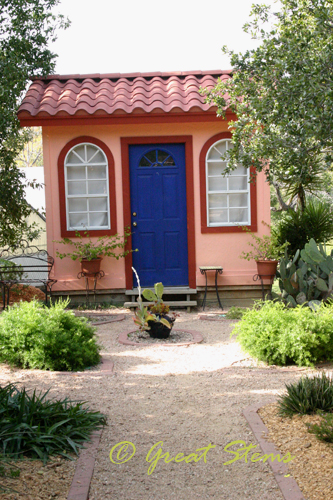
Two other styles were represented, a Manicured Xeriscape Lawn and a yard straight out of the Texas Hill Country. Certainly this look at yard styles and water-saving options gives one a lot to think about in terms of plant selection and design.
On the way back from San Antonio, we stopped at the Antique Rose Emporium near Selma. At first, I expected to be very much out of my element, as I don’t know a thing about roses. However, it’s hard not to take delight in the beauty and fragrance and variety of roses, and there were many native and Texas-adapted species as well, along with fun garden gifts.
This single white flower surrounded by pink buds was a bouquet all by itself.
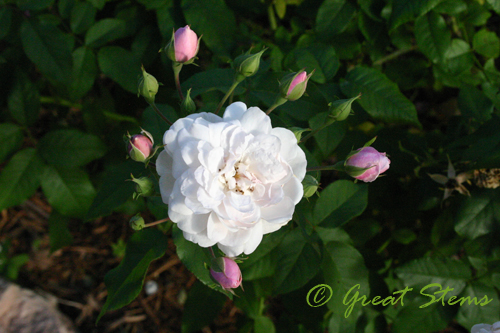 A white climbing rose in the “Mannerly Climbers” section drapes out of its pot.
A white climbing rose in the “Mannerly Climbers” section drapes out of its pot.
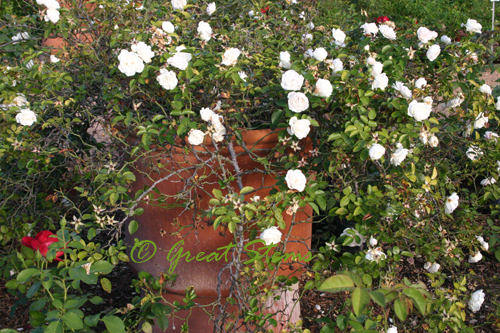 I was sorely tempted to go against my grain and choose a water-loving non-native Curly Willow to enjoy at home near my air-conditioner drain. But at the last moment, I resisted. I left with a native Passiflora and two kinds of wonderfully scented Pineapple Sage instead. If I ever have an appropriate bog, however, that Curly Willow might be mine for sheer fun!
I was sorely tempted to go against my grain and choose a water-loving non-native Curly Willow to enjoy at home near my air-conditioner drain. But at the last moment, I resisted. I left with a native Passiflora and two kinds of wonderfully scented Pineapple Sage instead. If I ever have an appropriate bog, however, that Curly Willow might be mine for sheer fun!
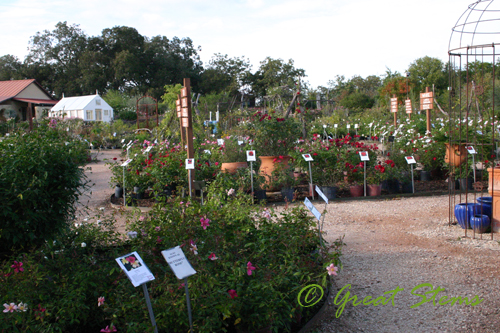
A good time had by all. Can you tell that this was the last picture taken of people restless from standing too long for photos? There were a lot of cameras “in line.”
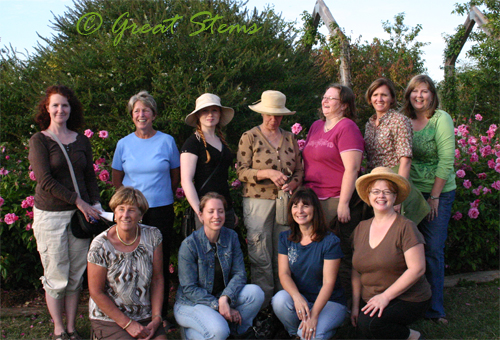
Time to go home. The cars that had room for plants were filled up completely, of course.
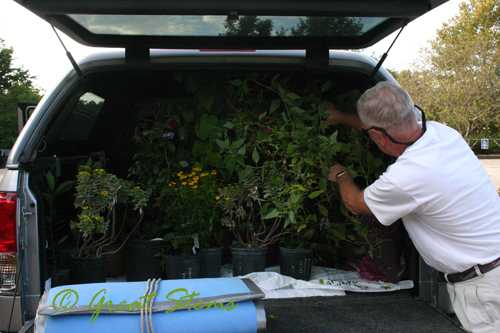
What a fulfilling, pleasant, happy day. Thanks, everyone!
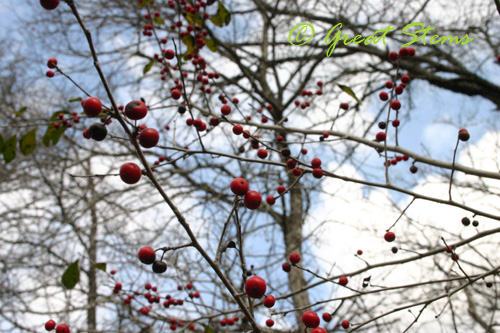
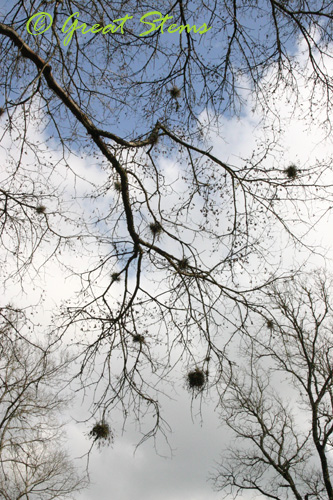
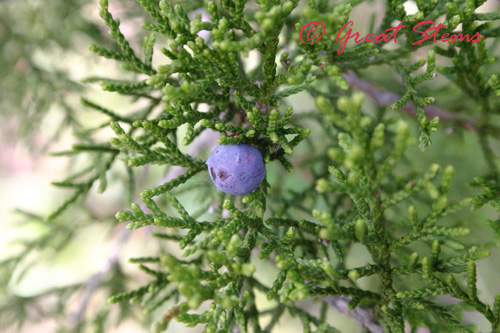 to red and green colors.
to red and green colors.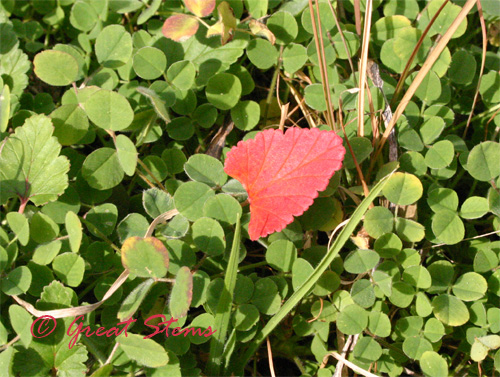
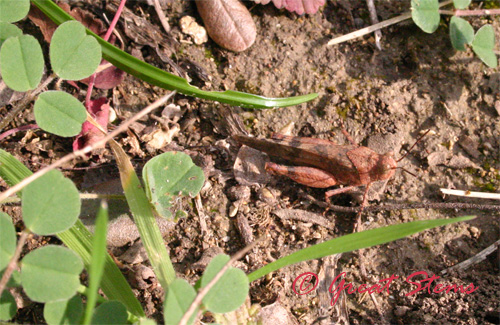
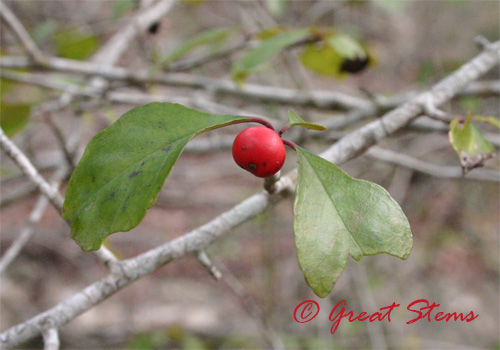
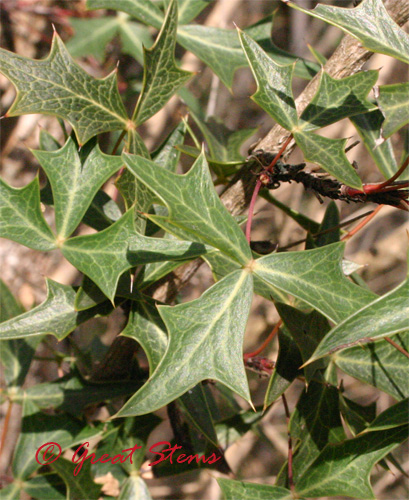
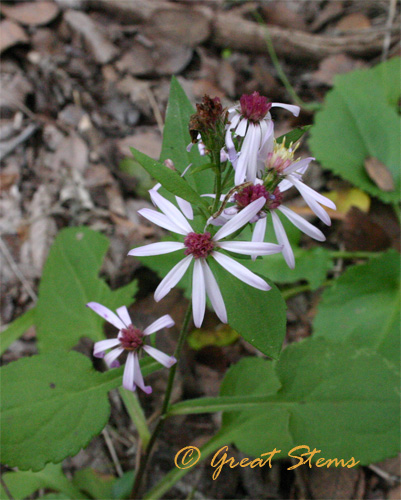 Sometimes we found unexpected shapes that brought our thoughts to ordinary objects or otherwise sparked our imagination, such as hearts…
Sometimes we found unexpected shapes that brought our thoughts to ordinary objects or otherwise sparked our imagination, such as hearts…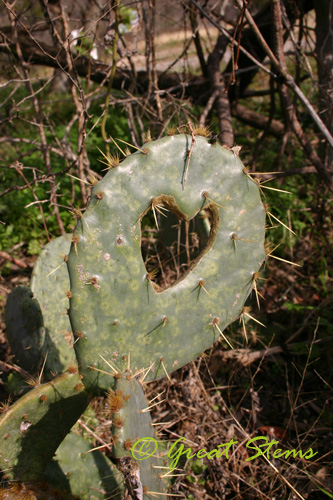
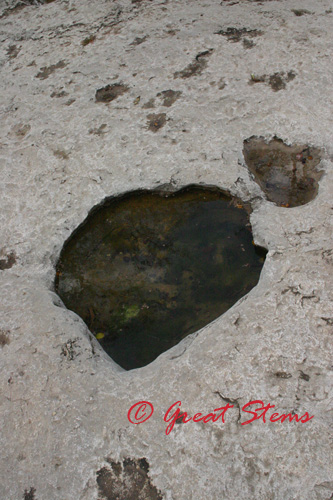
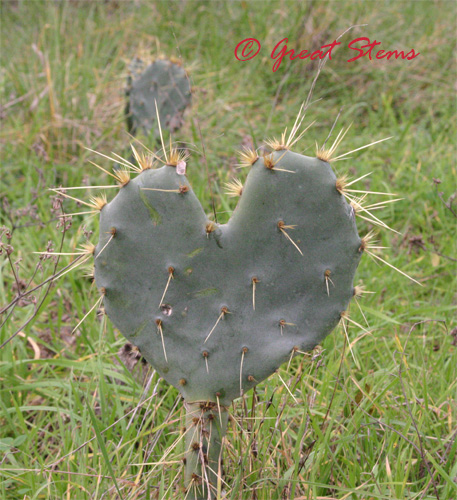
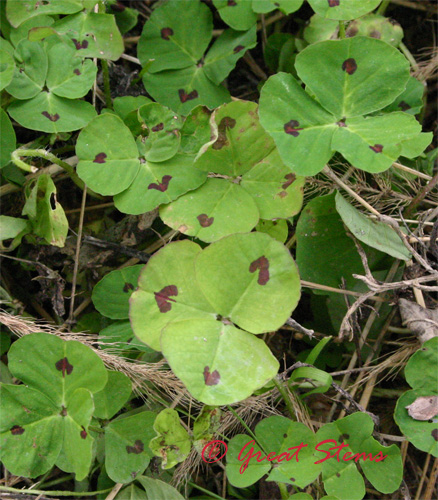 Bigfoot tracks…
Bigfoot tracks…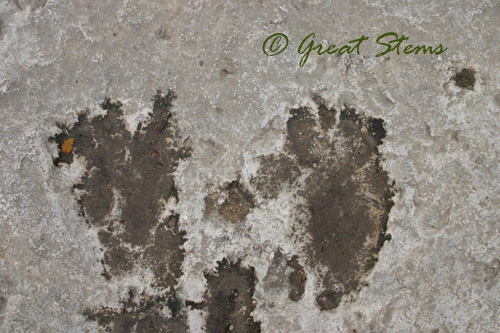 and even a longhorn. Hook ’em Horns!
and even a longhorn. Hook ’em Horns!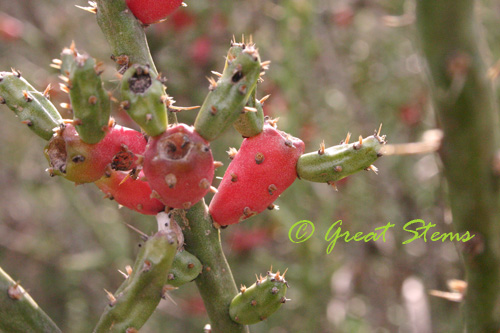
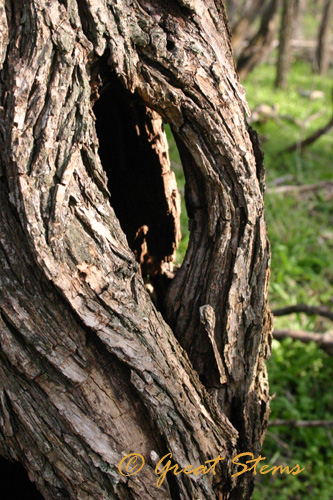
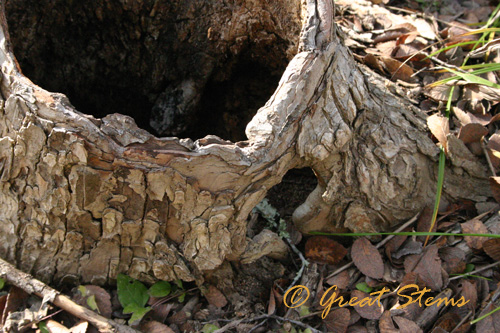
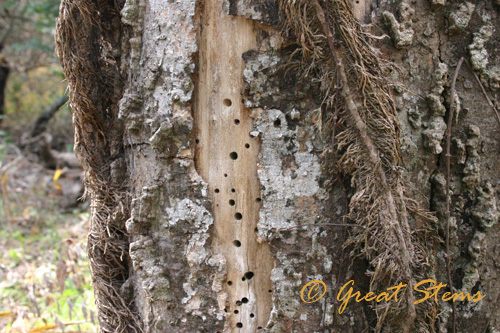 And we enjoyed a variety of textures, from the soft to the rough to the bristly.
And we enjoyed a variety of textures, from the soft to the rough to the bristly.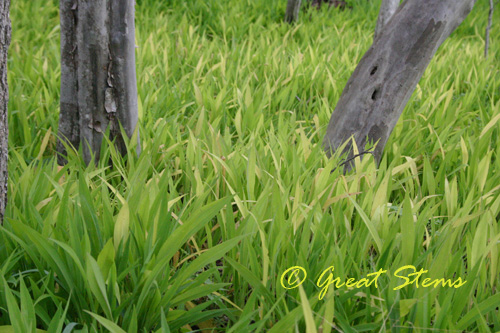
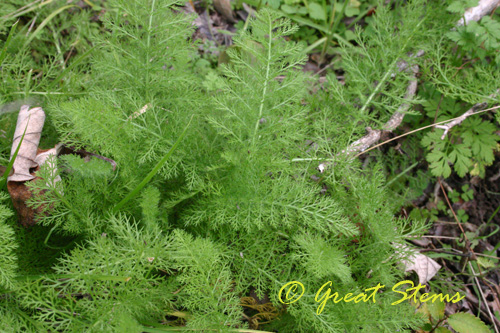
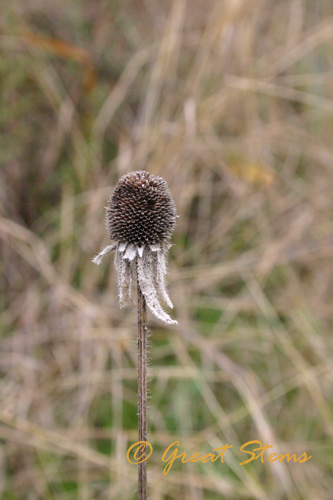
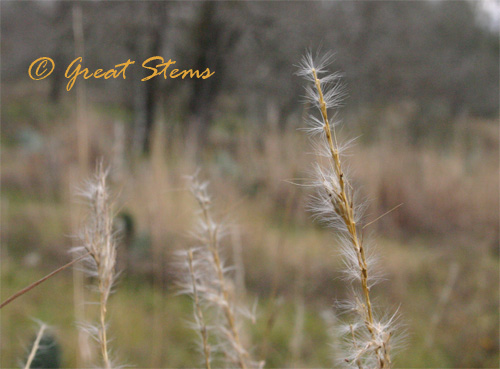
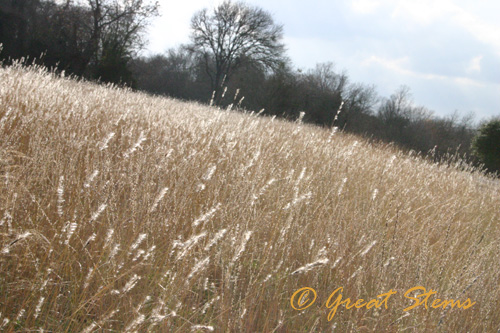
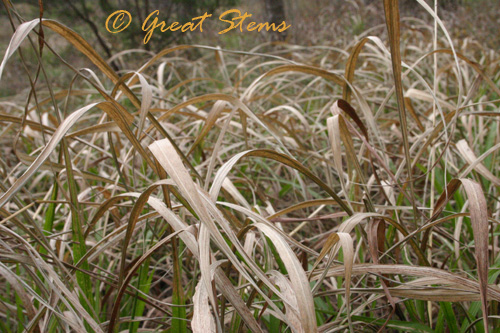
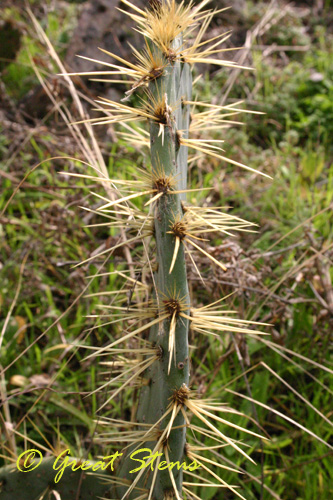 The cactus kept our attention, through color, shape, and spines. Sometimes it was pests, like cochineals…
The cactus kept our attention, through color, shape, and spines. Sometimes it was pests, like cochineals…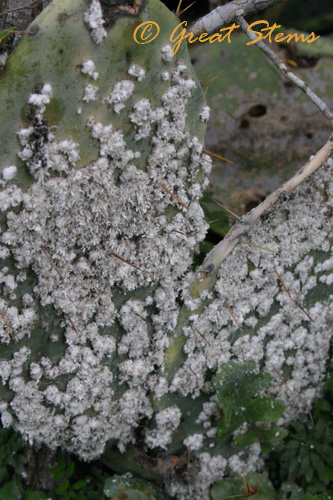
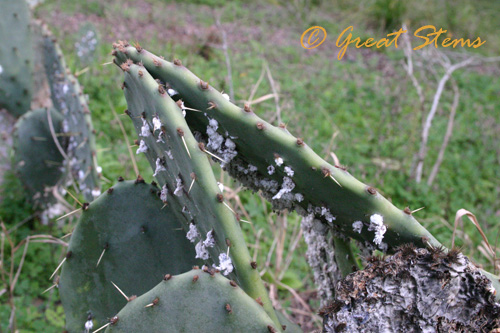 but sometimes it was beauty in age and decline. Have you ever wondered about the interior structure of a cactus, its vascular system that supports its water conservation? When dry, it leaves behind a beautifully intricate skeleton.
but sometimes it was beauty in age and decline. Have you ever wondered about the interior structure of a cactus, its vascular system that supports its water conservation? When dry, it leaves behind a beautifully intricate skeleton.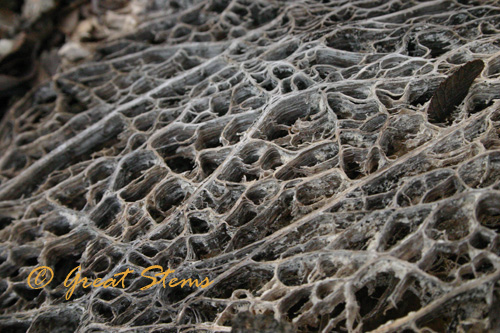
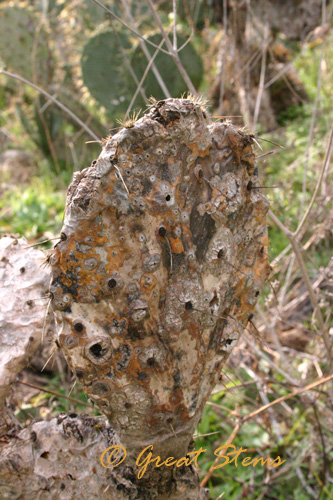
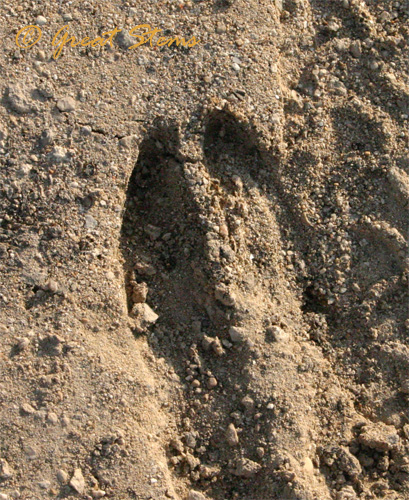
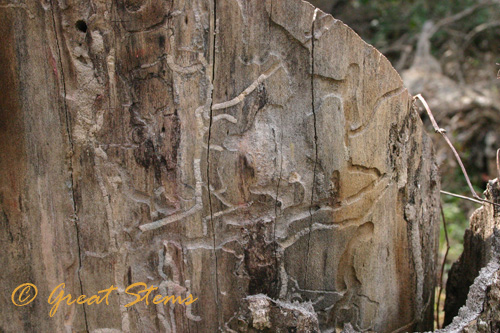 a lone butterfly…
a lone butterfly…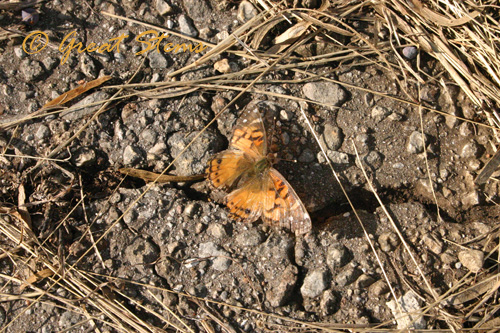 a flower staring back at us (you can really have a conversation with this flower if you choose to)…
a flower staring back at us (you can really have a conversation with this flower if you choose to)…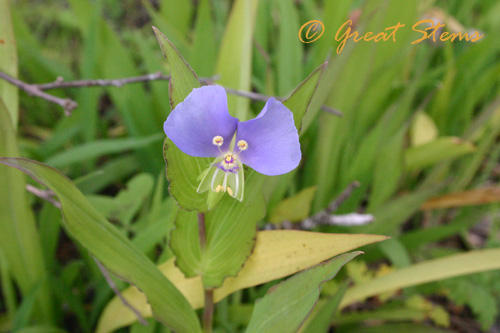 nifty things plants and fungus do…
nifty things plants and fungus do…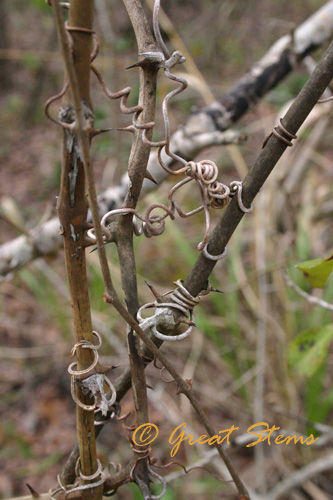
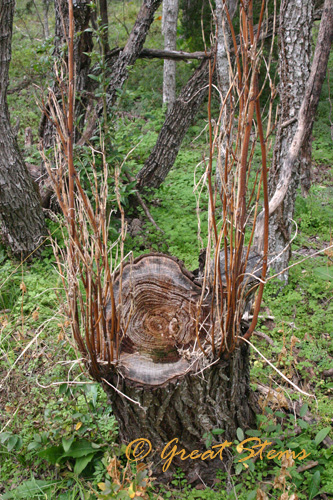
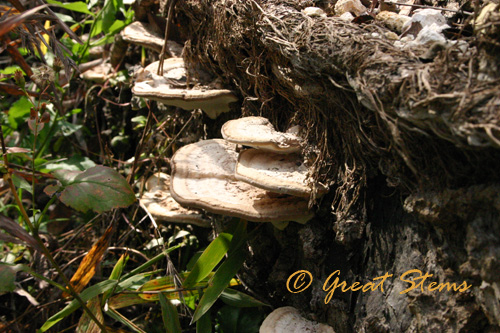 and vicious man-eating fire ants.
and vicious man-eating fire ants.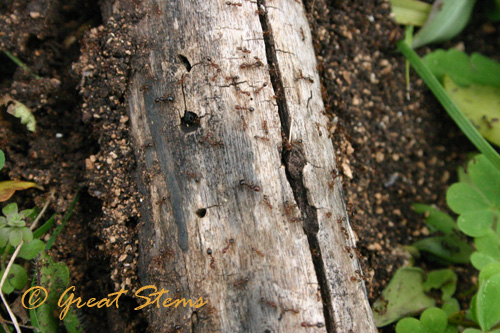 The winter season can keep some people indoors, but there is still so much to see, even when the leaves are on the ground instead of in the trees. Sometimes it’s noticing the little things that really open up the wonders of nature. And when you do it with your kids, you feel like you’re helping the whole world open up in their eyes.
The winter season can keep some people indoors, but there is still so much to see, even when the leaves are on the ground instead of in the trees. Sometimes it’s noticing the little things that really open up the wonders of nature. And when you do it with your kids, you feel like you’re helping the whole world open up in their eyes.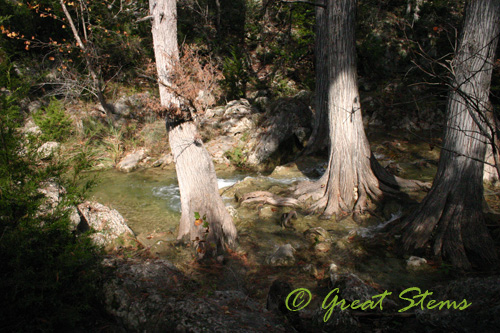
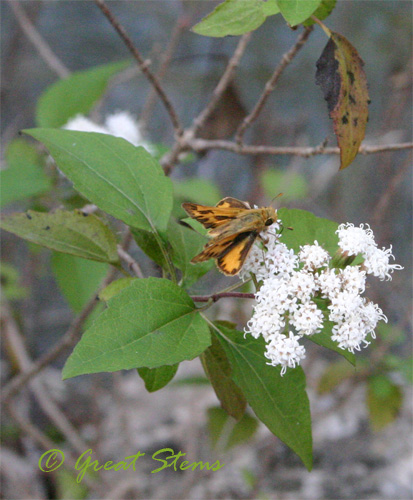
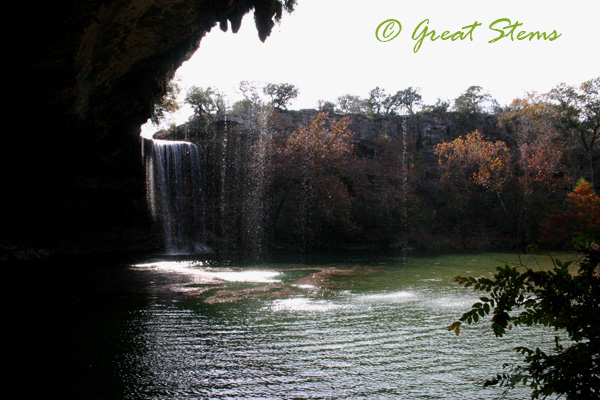
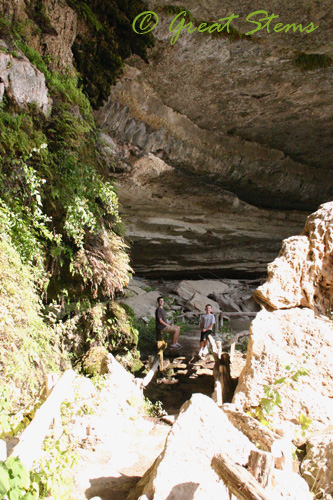
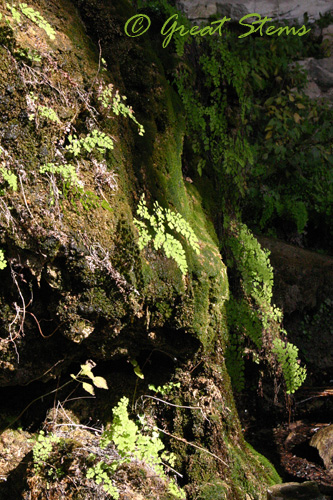
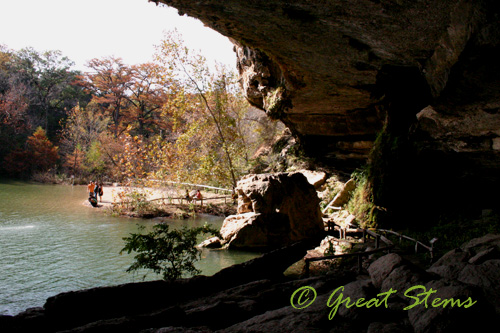 And from the back, the autumn colors seem all the more vibrant.
And from the back, the autumn colors seem all the more vibrant.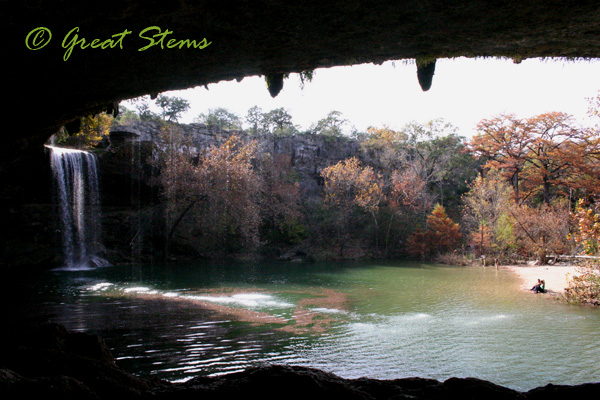
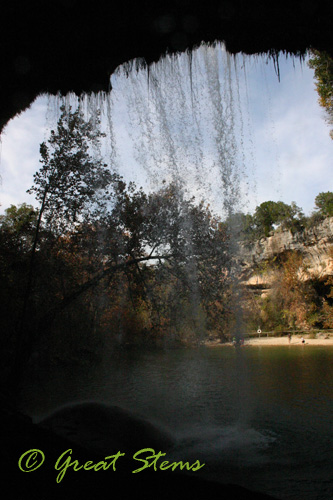
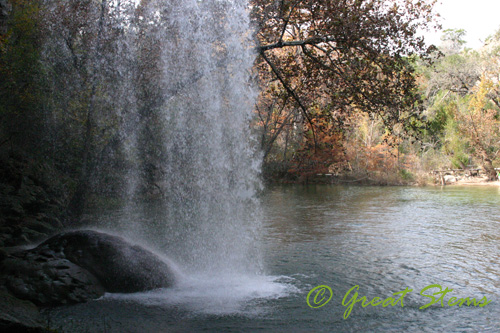
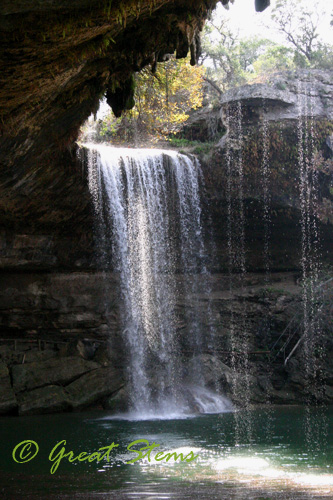
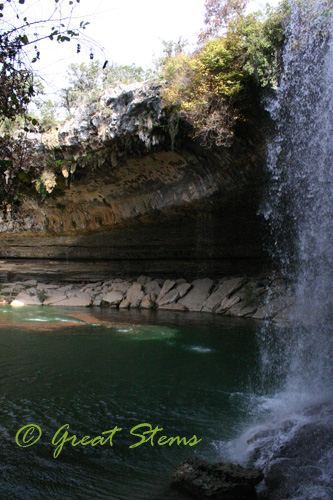
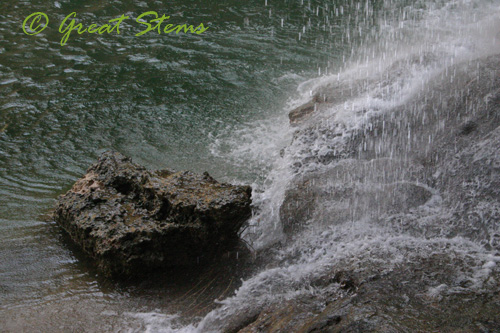
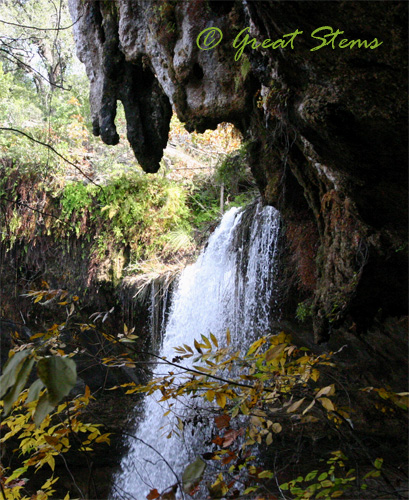
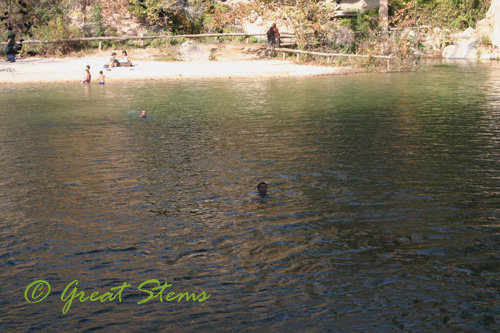
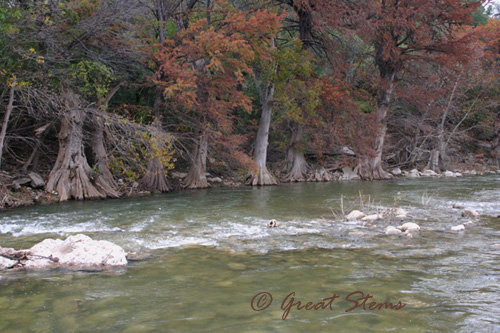
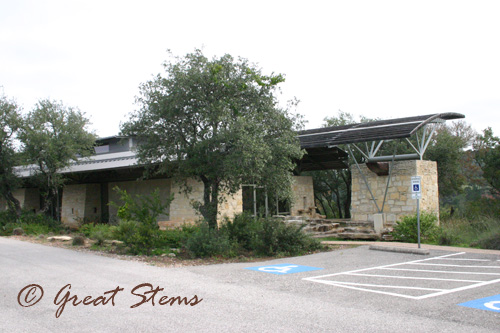
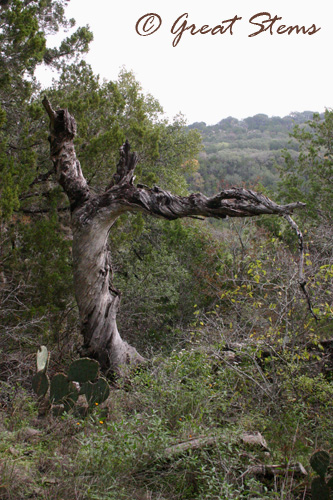
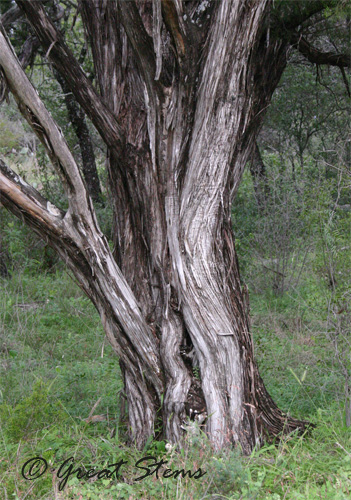
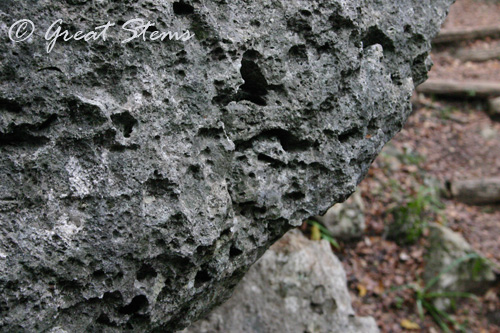
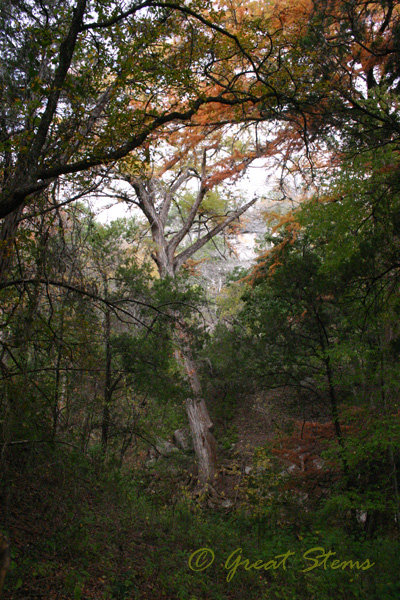
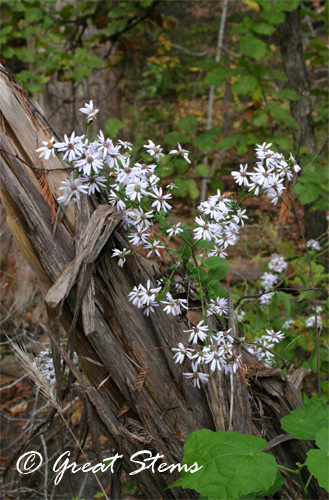
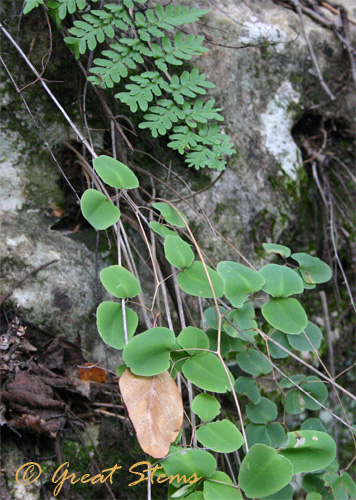
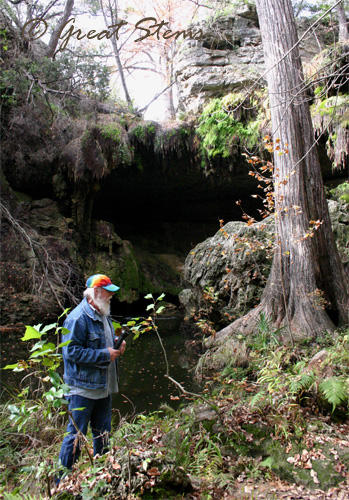
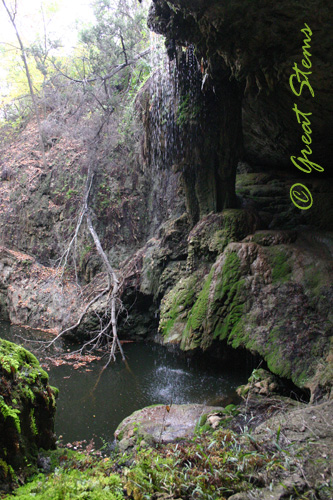
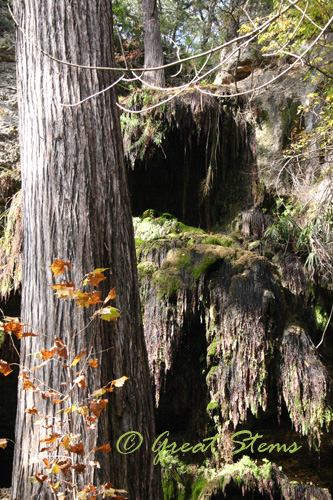
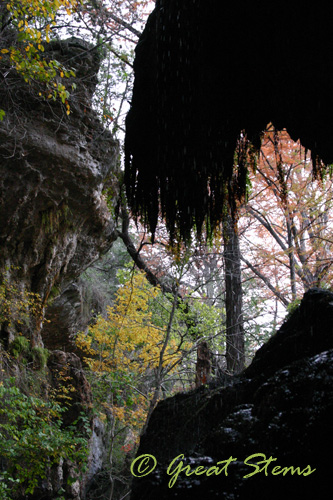 Sunlight streamed into the cave, providing backlighting for glistening water drops and shining upon the moistened moss and ferns. The almost fantastical scene seemed perfect for little gnomes, fairies, or elves.
Sunlight streamed into the cave, providing backlighting for glistening water drops and shining upon the moistened moss and ferns. The almost fantastical scene seemed perfect for little gnomes, fairies, or elves.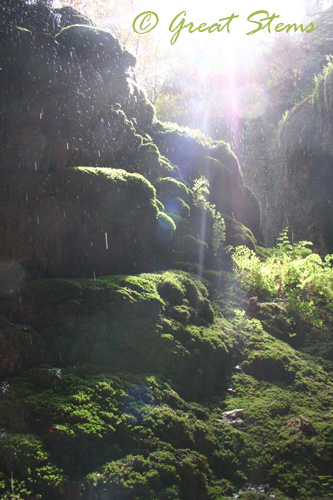
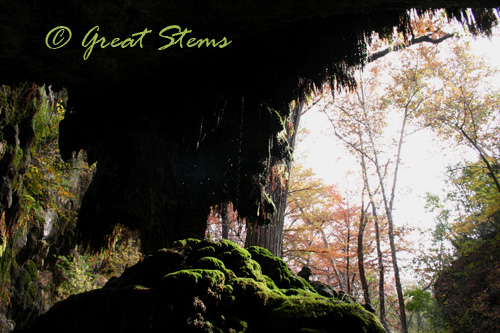
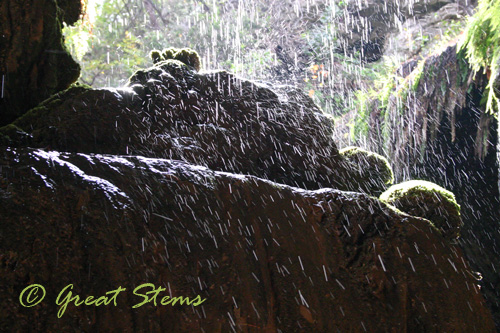
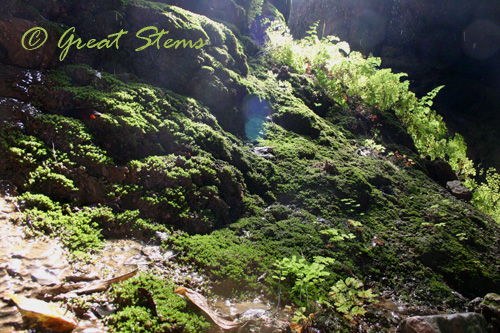
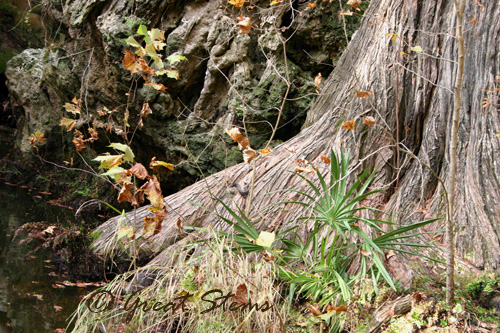
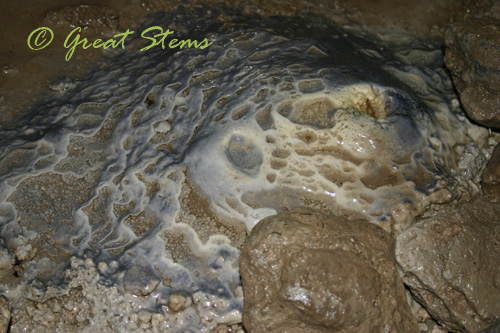
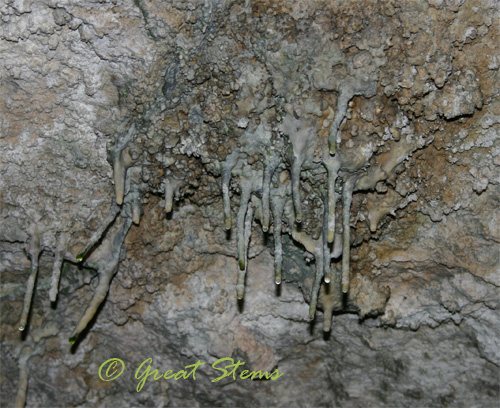
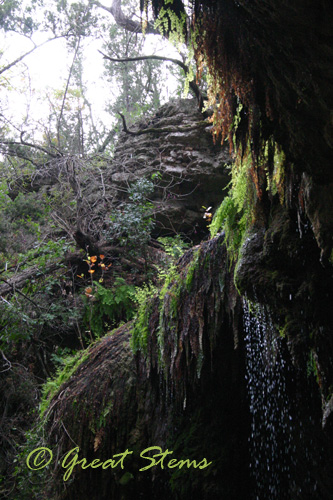
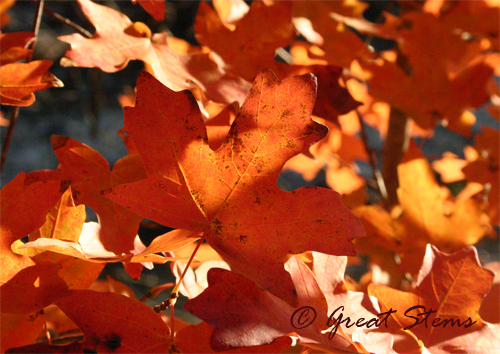 During our visit, the woods were a colorful palette of greens, golds, oranges, reds, and browns. The colors come from the Bigtooth Maples, Red Oaks, Lacey Oaks, Flameleaf Sumacs, and other trees, and even vines such as Virginia Creeper and Poison Ivy.
During our visit, the woods were a colorful palette of greens, golds, oranges, reds, and browns. The colors come from the Bigtooth Maples, Red Oaks, Lacey Oaks, Flameleaf Sumacs, and other trees, and even vines such as Virginia Creeper and Poison Ivy.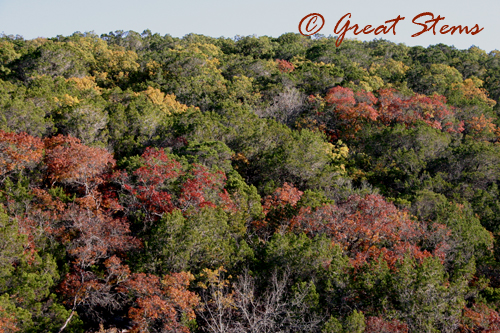
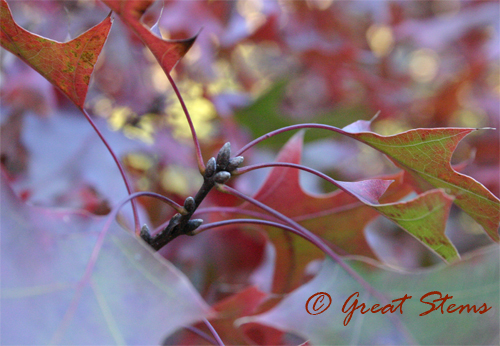
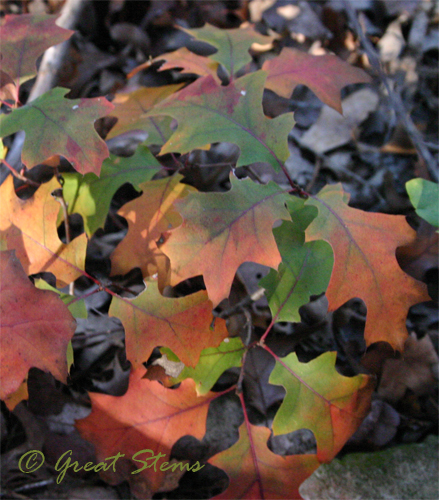 But when the trees were ready, they really did the colors right.
But when the trees were ready, they really did the colors right.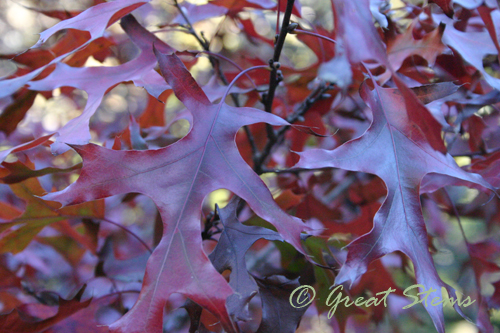
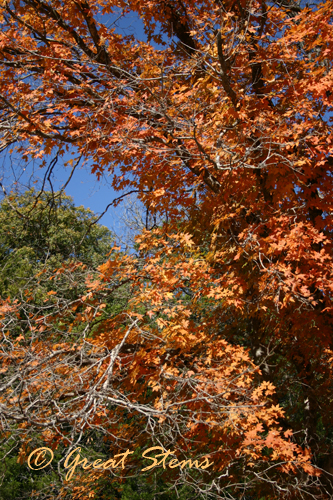
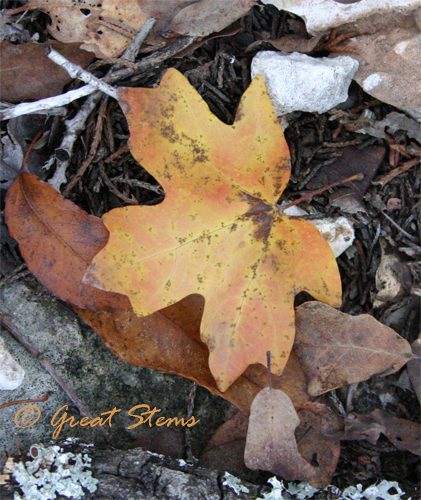
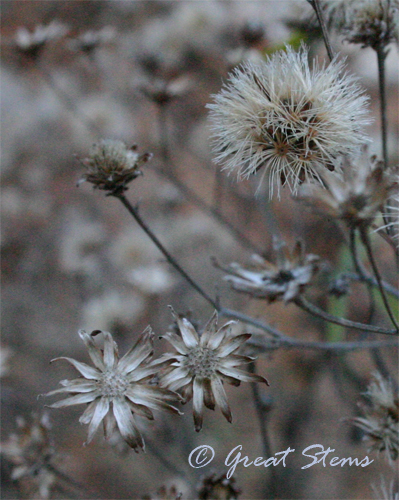
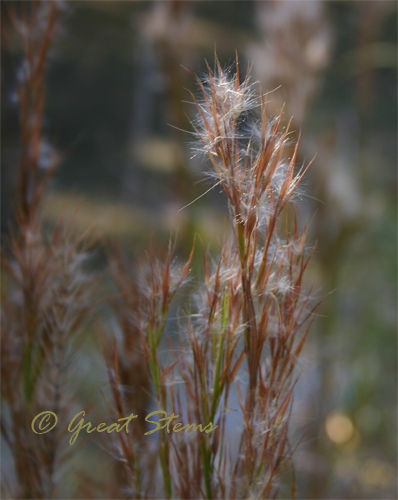
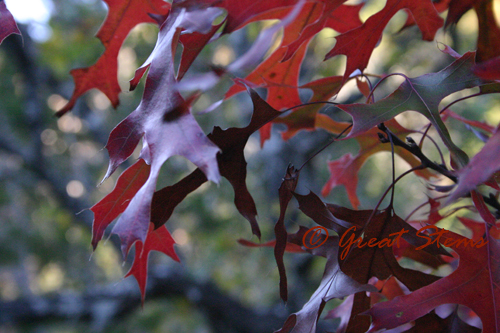
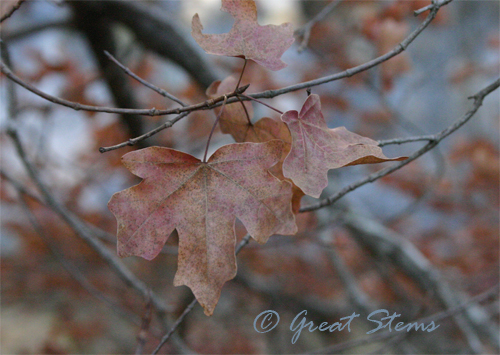
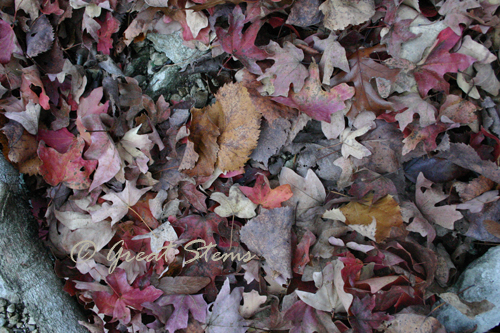
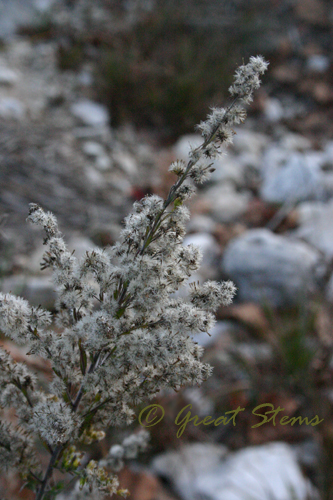
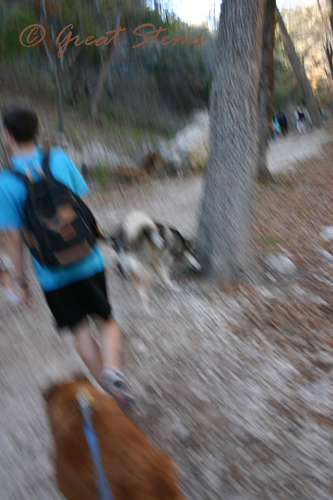 Lost Maples’ most popular trail is a short, relatively easy walk, but we opted for the almost-5-mile East Trail. Shortly into the hike, we were met by a sign that read something along the lines of “Steep Trail for the Next 1.5 Miles.” It was not just steep — it was very, very rocky, too. And you know, what goes up, must come down.
Lost Maples’ most popular trail is a short, relatively easy walk, but we opted for the almost-5-mile East Trail. Shortly into the hike, we were met by a sign that read something along the lines of “Steep Trail for the Next 1.5 Miles.” It was not just steep — it was very, very rocky, too. And you know, what goes up, must come down. 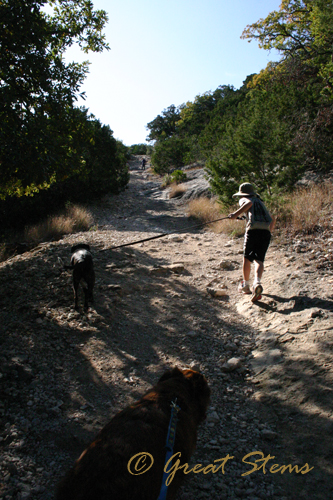
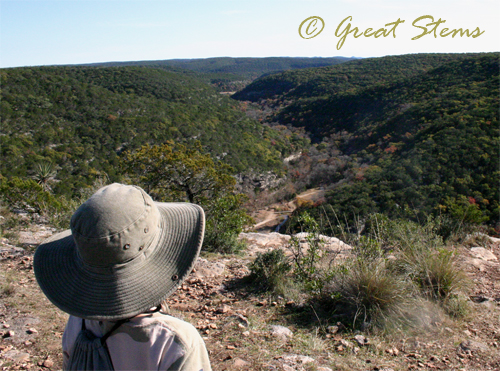
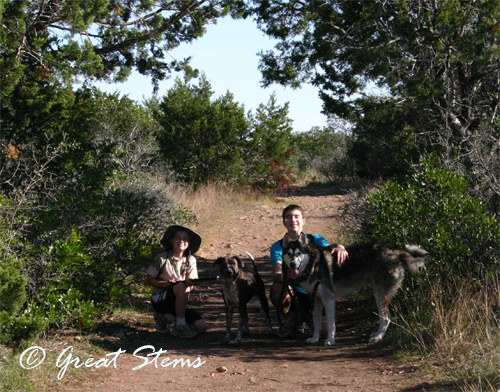 As we made our way down the other side of the mountain, the stunning fall foliage came forth again.
As we made our way down the other side of the mountain, the stunning fall foliage came forth again.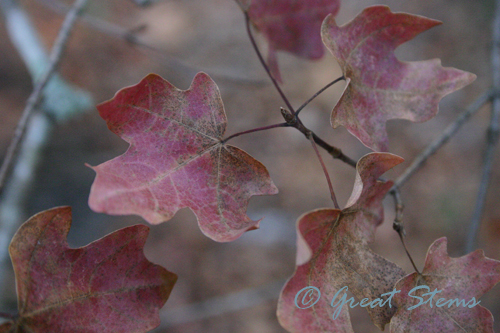
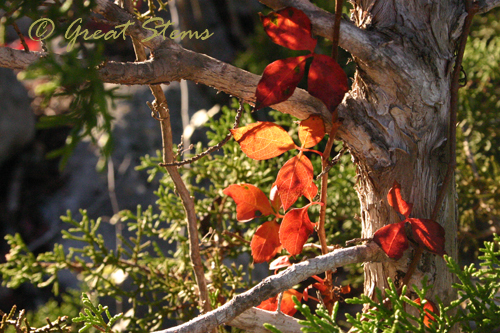
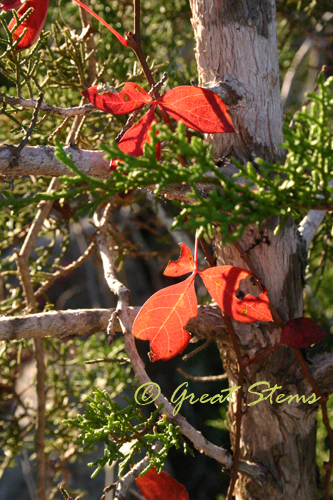
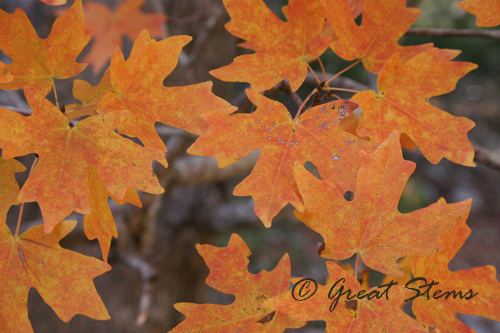
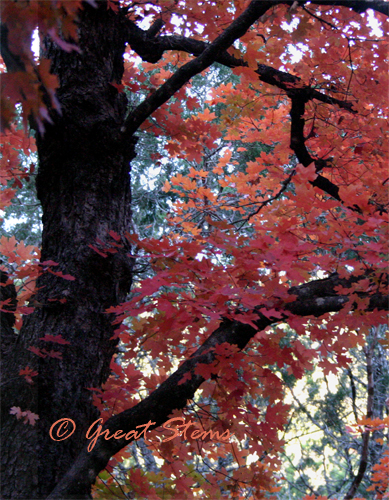
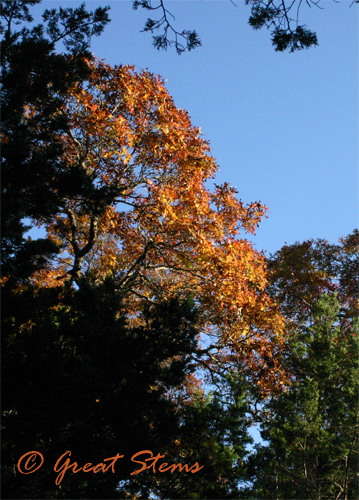
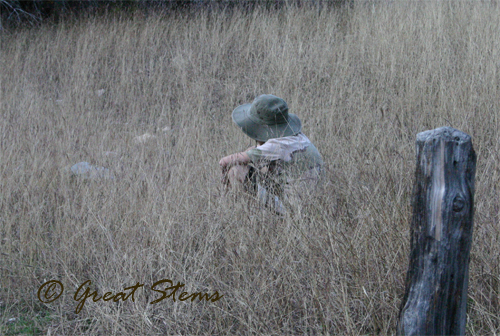
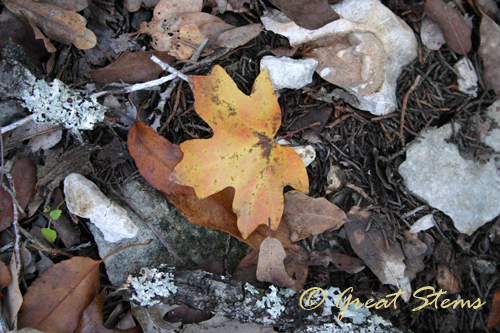

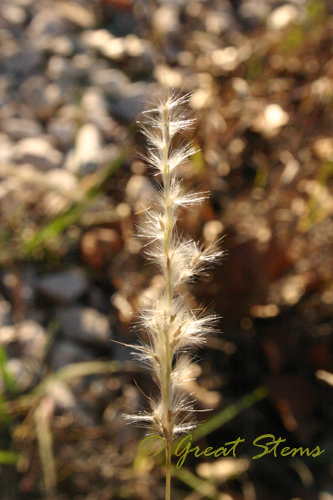
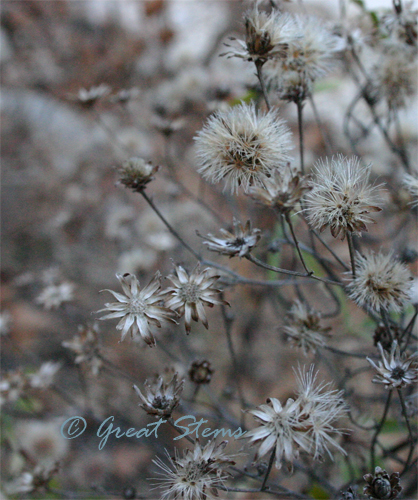
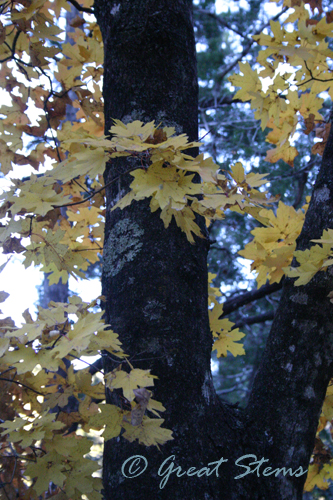
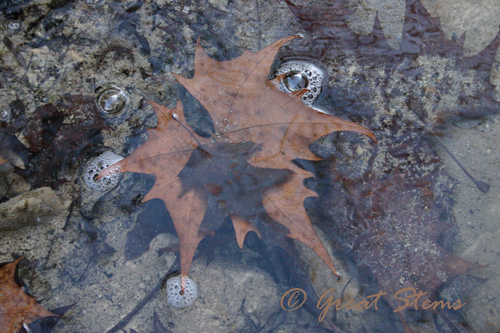
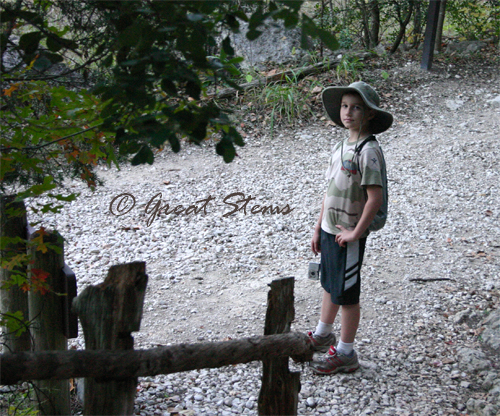
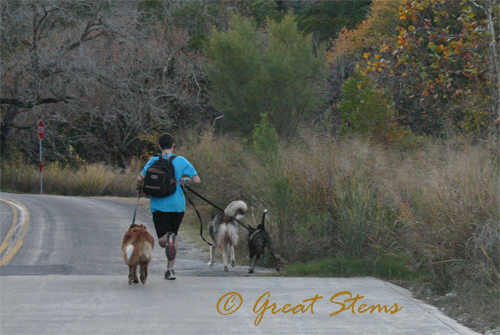 On our way home, we stopped at Stonehenge II, a smaller version of its more famous archaeological wonder of a cousin. It also has an Easter Island-like statue. It was getting dark, so we snapped a picture and headed on. A nifty spot to visit — we’ll go back in daylight.
On our way home, we stopped at Stonehenge II, a smaller version of its more famous archaeological wonder of a cousin. It also has an Easter Island-like statue. It was getting dark, so we snapped a picture and headed on. A nifty spot to visit — we’ll go back in daylight.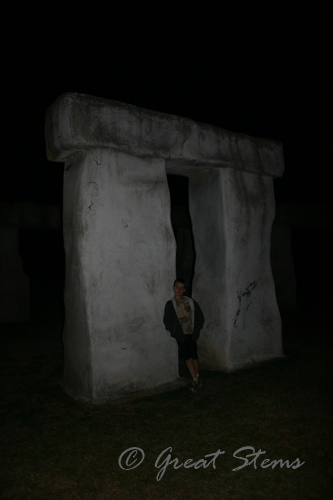







 Bird of Paradise
Bird of Paradise




























 I was wowed by the simple design but elaborate effect of the fence surrounding the Japanese garden.
I was wowed by the simple design but elaborate effect of the fence surrounding the Japanese garden. In addition to special exotic areas of SABot, the gardens also had areas focused on different Texas regions, such as South Texas, Hill Country, and this scenic lake setting representative of the East Texas Pineywoods. The reflections on the water were occasionally disturbed by a falling maple leaf or a duck creating a “V” while swimming across the still water.
In addition to special exotic areas of SABot, the gardens also had areas focused on different Texas regions, such as South Texas, Hill Country, and this scenic lake setting representative of the East Texas Pineywoods. The reflections on the water were occasionally disturbed by a falling maple leaf or a duck creating a “V” while swimming across the still water.






 In the same garden, it might be tempting to touch this bumpy plant, but a closer look shows that each bump ends in a tiny and very painful spine. I wondered whether it really should be in a Sensory Garden, then realized that it was just barely kept out of eager hands’ reach. I guess an attempt was made to correct the mistake, if it was one.
In the same garden, it might be tempting to touch this bumpy plant, but a closer look shows that each bump ends in a tiny and very painful spine. I wondered whether it really should be in a Sensory Garden, then realized that it was just barely kept out of eager hands’ reach. I guess an attempt was made to correct the mistake, if it was one. 









 Many of the windows of the glass pavilions had been replaced with boards. It turns out that some of these had been damaged by deliberate gunshots from nearby Sam Houston. I’m quite appalled and upset about this. American soldiers and officers should be role models, not thugs.
Many of the windows of the glass pavilions had been replaced with boards. It turns out that some of these had been damaged by deliberate gunshots from nearby Sam Houston. I’m quite appalled and upset about this. American soldiers and officers should be role models, not thugs.
 How about a Cottage-Garden style, with reduced lawn and colorful flower beds?
How about a Cottage-Garden style, with reduced lawn and colorful flower beds? Or a Wildscape Landscape, complete with curvy paths, reduced lawn, and plants selected for their value to birds, butterflies, and other wildlife?
Or a Wildscape Landscape, complete with curvy paths, reduced lawn, and plants selected for their value to birds, butterflies, and other wildlife? Or do you prefer the style of a Spanish courtyard?
Or do you prefer the style of a Spanish courtyard?
 A white climbing rose in the “Mannerly Climbers” section drapes out of its pot.
A white climbing rose in the “Mannerly Climbers” section drapes out of its pot. I was sorely tempted to go against my grain and choose a water-loving non-native Curly Willow to enjoy at home near my air-conditioner drain. But at the last moment, I resisted. I left with a native Passiflora and two kinds of wonderfully scented Pineapple Sage instead. If I ever have an appropriate bog, however, that Curly Willow might be mine for sheer fun!
I was sorely tempted to go against my grain and choose a water-loving non-native Curly Willow to enjoy at home near my air-conditioner drain. But at the last moment, I resisted. I left with a native Passiflora and two kinds of wonderfully scented Pineapple Sage instead. If I ever have an appropriate bog, however, that Curly Willow might be mine for sheer fun!


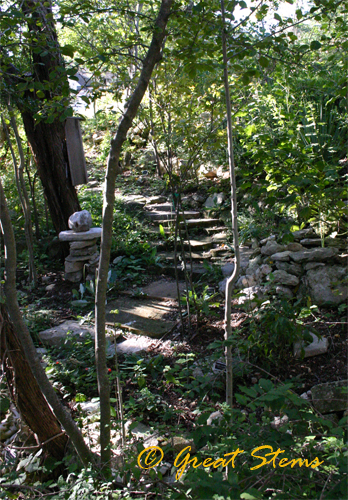 I had heard a lot about their spectacular wildscape, so when our Habitat Steward group was given the opportunity to have a tour, you know I jumped at the chance!
I had heard a lot about their spectacular wildscape, so when our Habitat Steward group was given the opportunity to have a tour, you know I jumped at the chance!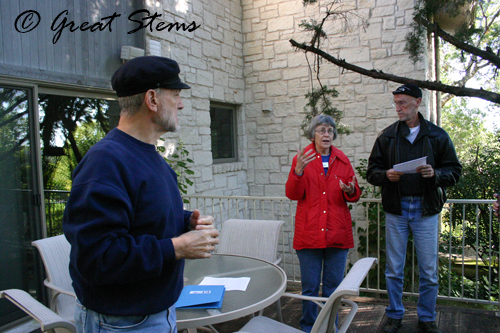
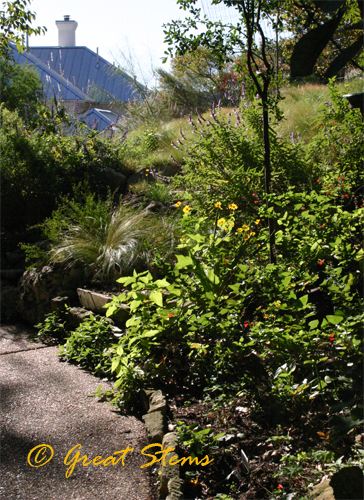 Pat and Dale have lived on their property since 1998, building their home on a rocky limestone slope overlooking the Balcones Canyonland Preserves. Their efforts to create a natural landscape since then have paid off — paths of natural materials such as mulch, rock, and cedar lead visitors through peaceful woods and past pocket seeps.
Pat and Dale have lived on their property since 1998, building their home on a rocky limestone slope overlooking the Balcones Canyonland Preserves. Their efforts to create a natural landscape since then have paid off — paths of natural materials such as mulch, rock, and cedar lead visitors through peaceful woods and past pocket seeps.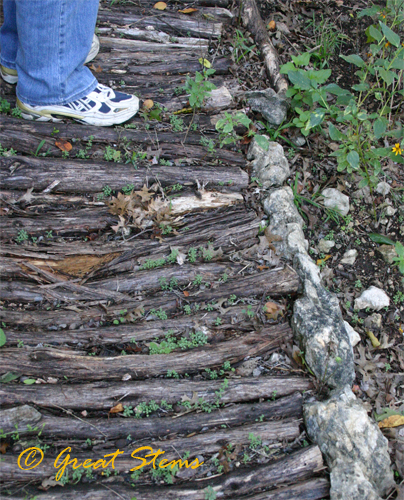 Many of the plants were placed there by the Bullas, but many more were delivered by birds and other creatures. The result is a wonderland of native Texas species.
Many of the plants were placed there by the Bullas, but many more were delivered by birds and other creatures. The result is a wonderland of native Texas species.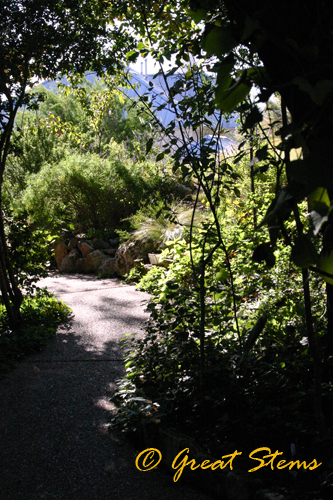
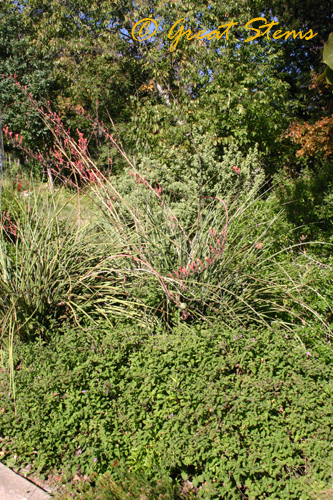
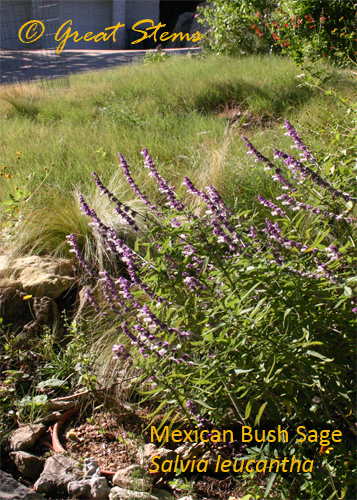
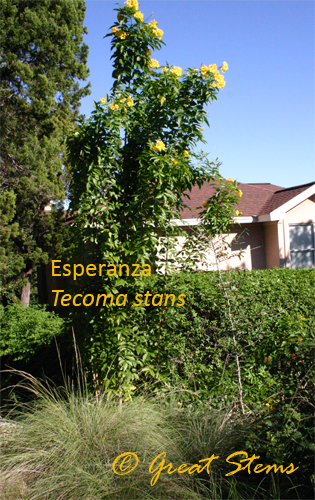 Pat told me that the plants on their property are about 95% native, with the remaining being well adapted plants such as rosemary and winter-blooming germander.
Pat told me that the plants on their property are about 95% native, with the remaining being well adapted plants such as rosemary and winter-blooming germander.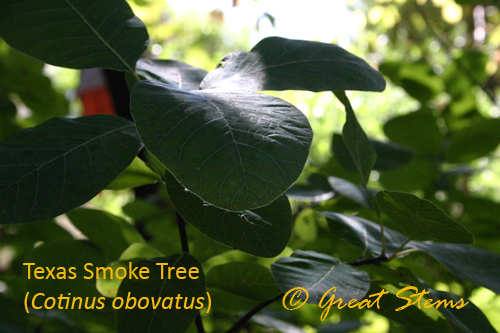
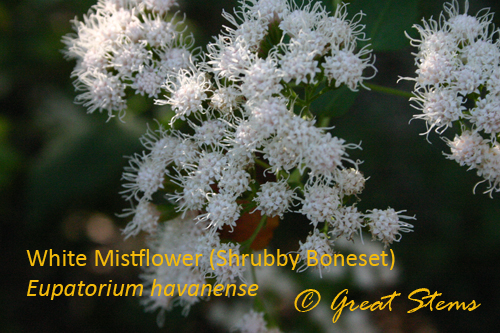
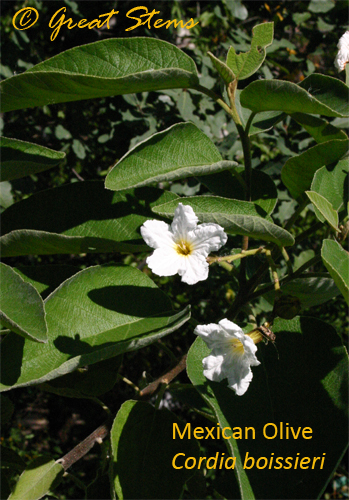
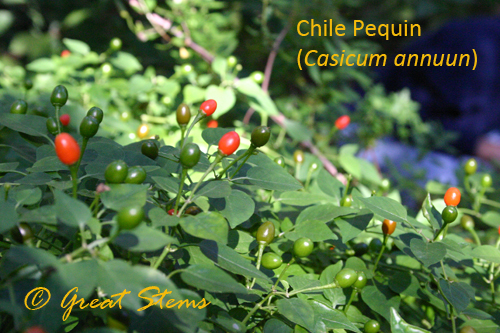
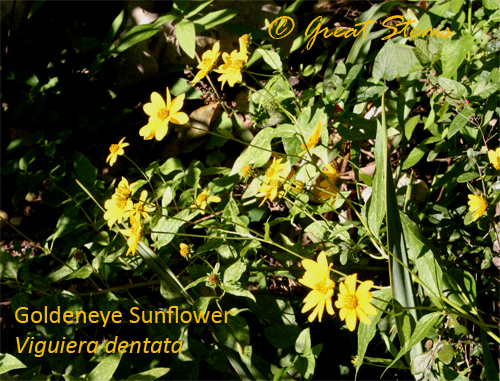
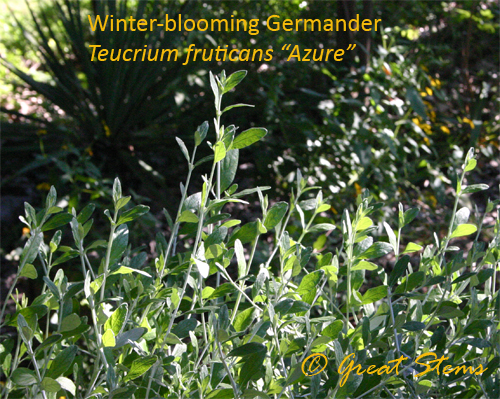
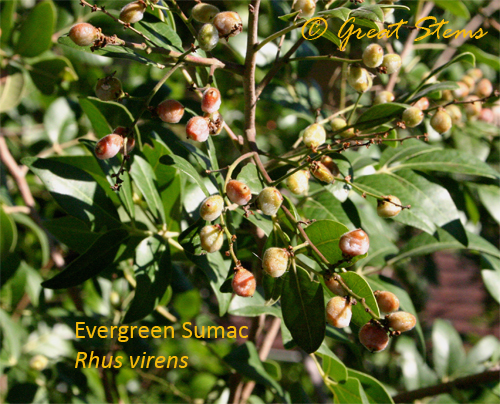
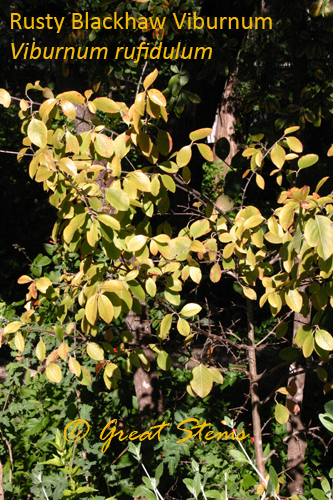
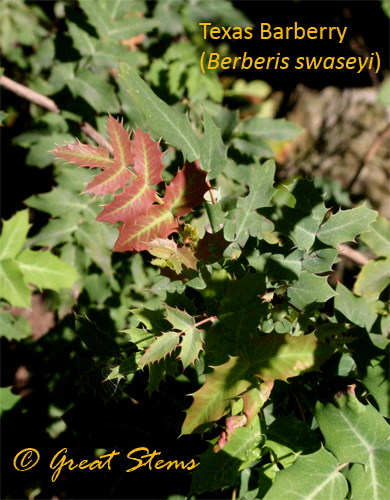
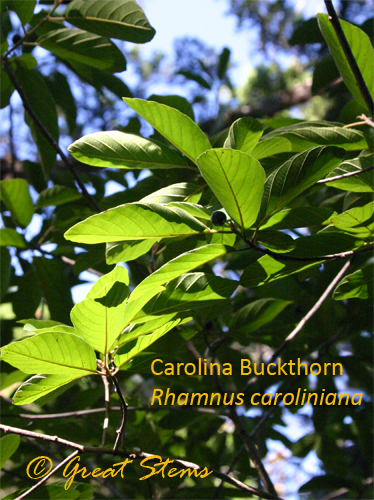
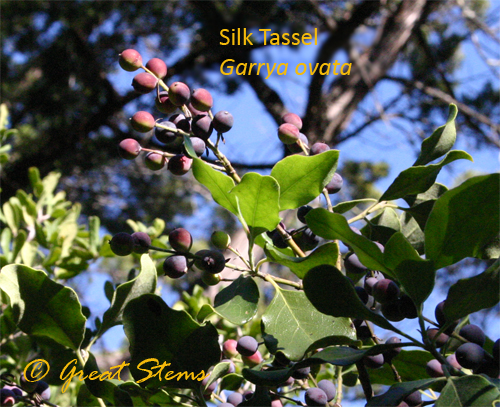
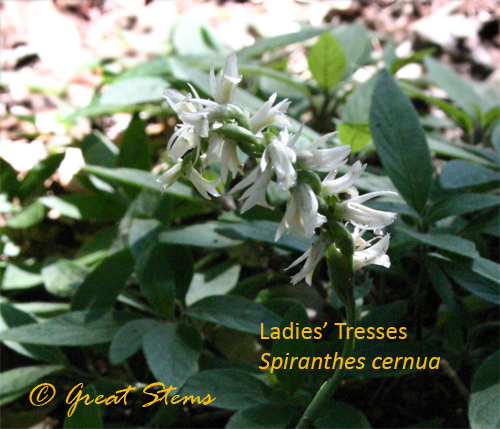
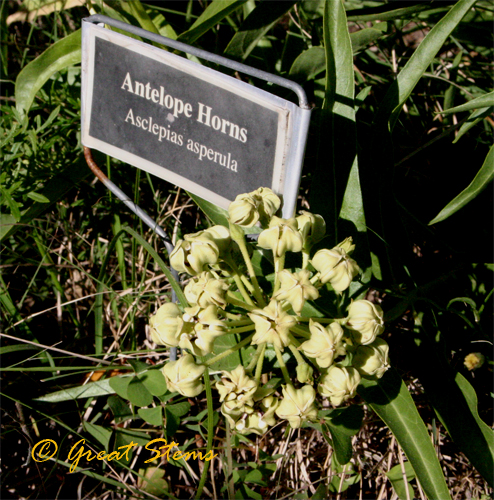
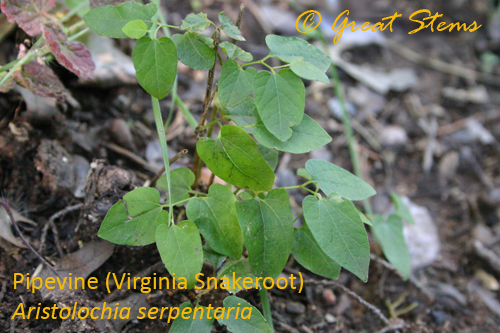
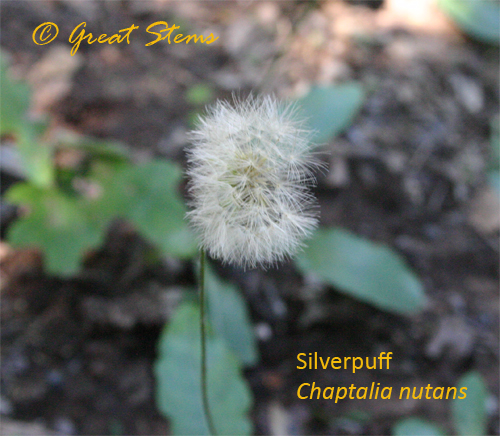
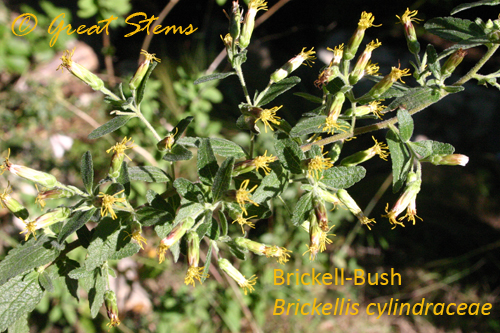
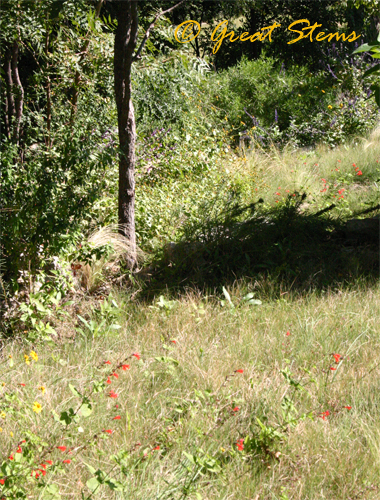
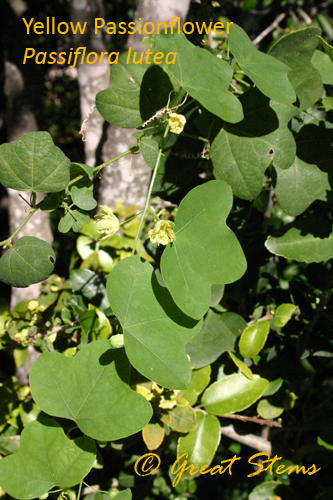
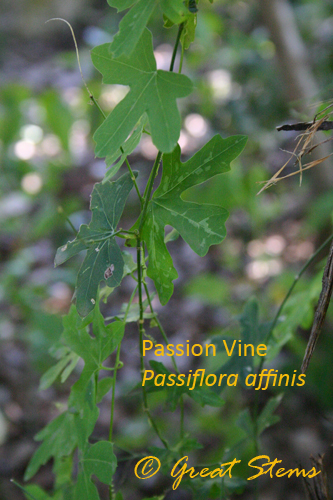
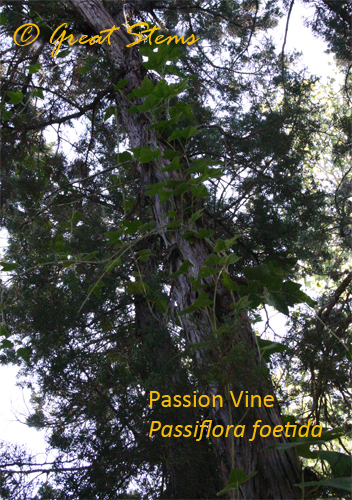
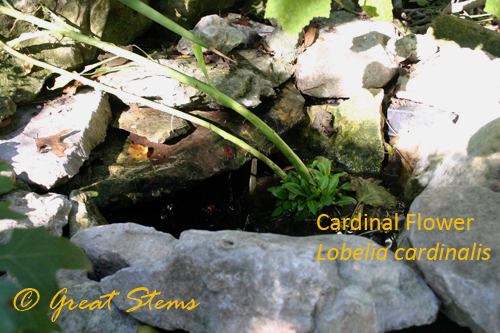
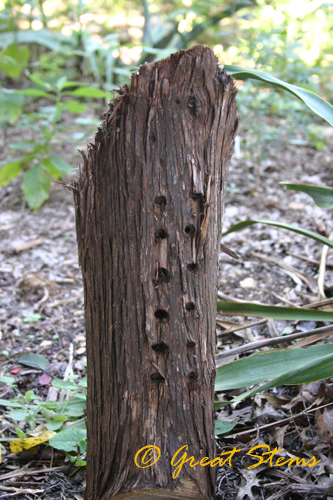
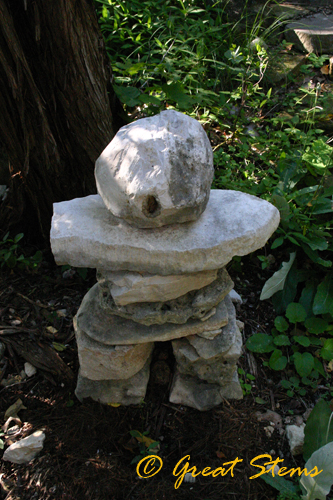
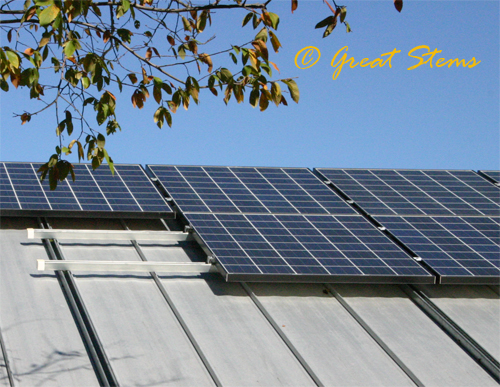 And of course, the wildlife love the Bullas’ habitat, too. Unfortunately for the Bullas, however, this includes destructive feral hogs that visit the property from the BCP during the night, occasionally tearing up pathways and plants while looking for grubs, roots, and tasty vegetation. Deer prevent Dale and Pat from planting certain delectable species and veggies, too. But birds, butterflies, lizards, and other creatures call the Bullas’ habitat home. We enjoyed watching the Queens and Monarchs fluttering about, but I was truly mesmerized by this Buckeye. I have yet to see a Buckeye in my yard!
And of course, the wildlife love the Bullas’ habitat, too. Unfortunately for the Bullas, however, this includes destructive feral hogs that visit the property from the BCP during the night, occasionally tearing up pathways and plants while looking for grubs, roots, and tasty vegetation. Deer prevent Dale and Pat from planting certain delectable species and veggies, too. But birds, butterflies, lizards, and other creatures call the Bullas’ habitat home. We enjoyed watching the Queens and Monarchs fluttering about, but I was truly mesmerized by this Buckeye. I have yet to see a Buckeye in my yard!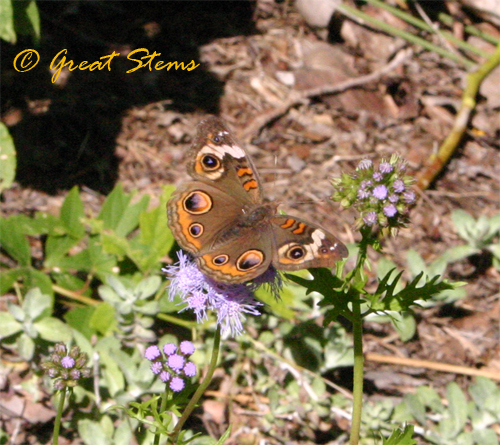 It’s no wonder the Bullas’ habitat is designated as a Green Garden by the City of Austin. An award well deserved!
It’s no wonder the Bullas’ habitat is designated as a Green Garden by the City of Austin. An award well deserved!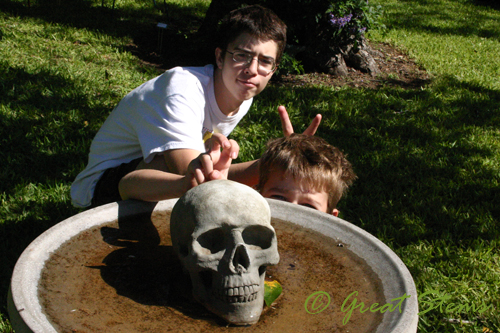
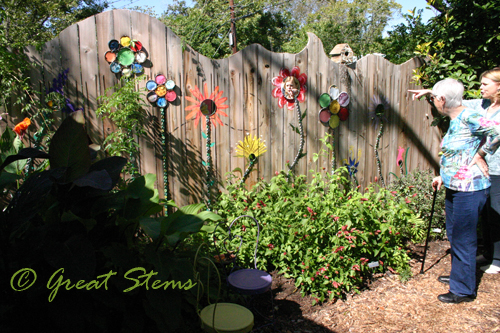
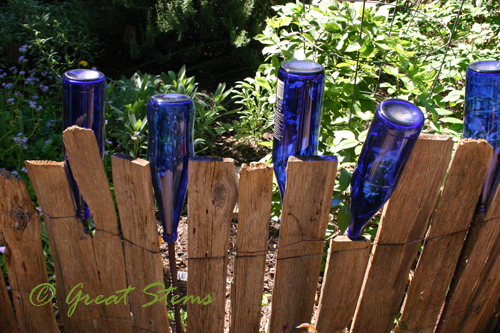
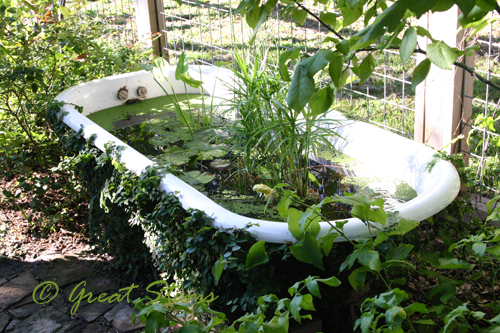
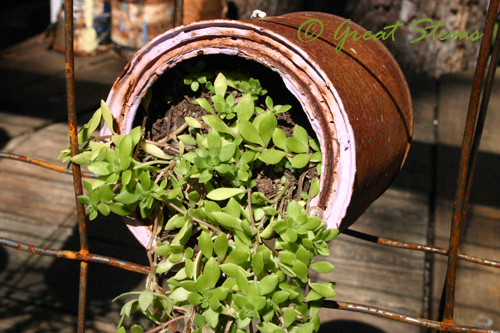
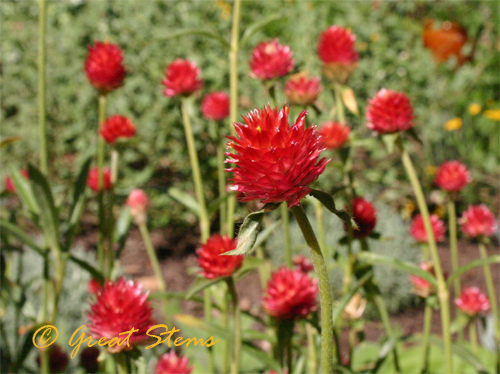
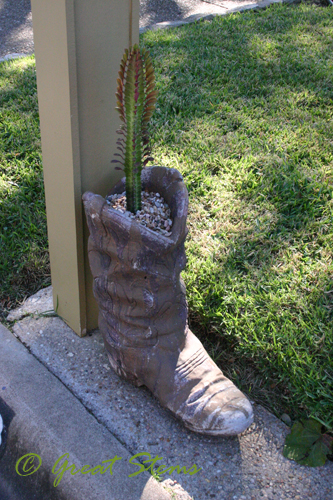
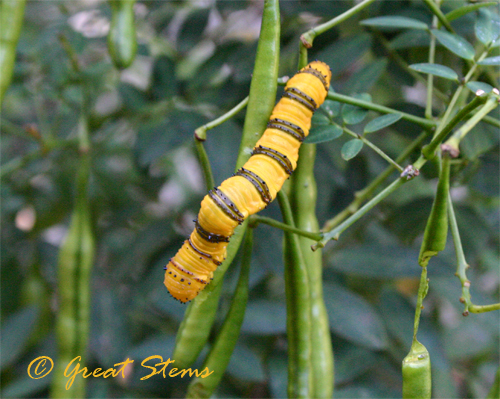
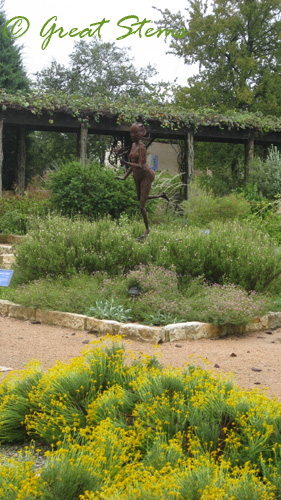 Spectacular combinations of colors and textures bring unconscious serenity to the viewer. Here the majestic Goldenrod really stands out against the wispy seeds and grasses of Big Muhly.
Spectacular combinations of colors and textures bring unconscious serenity to the viewer. Here the majestic Goldenrod really stands out against the wispy seeds and grasses of Big Muhly.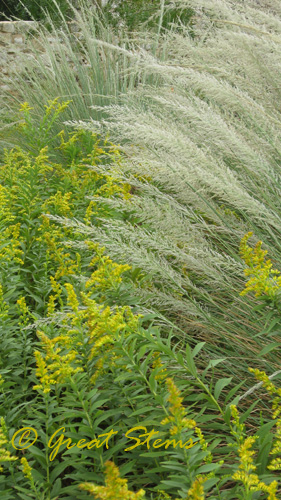
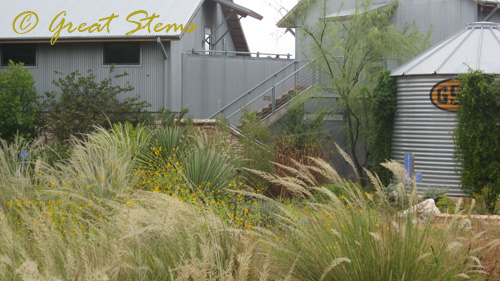 It was my husband’s first time to the Wildflower Center, so we did a quick little walkaround, but there wasn’t much time to take a thorough tour. There is so much more the center offers, from truly impressive rain collection systems to walking trails to green roof research to continuing education courses, and more.
It was my husband’s first time to the Wildflower Center, so we did a quick little walkaround, but there wasn’t much time to take a thorough tour. There is so much more the center offers, from truly impressive rain collection systems to walking trails to green roof research to continuing education courses, and more.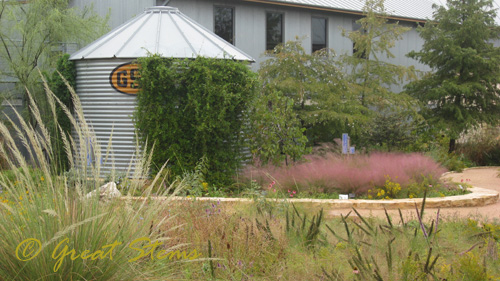 But twice a year, Texan gardeners get very excited about a special event that takes place at the Wildflower Center. The center hosts an outstanding
But twice a year, Texan gardeners get very excited about a special event that takes place at the Wildflower Center. The center hosts an outstanding 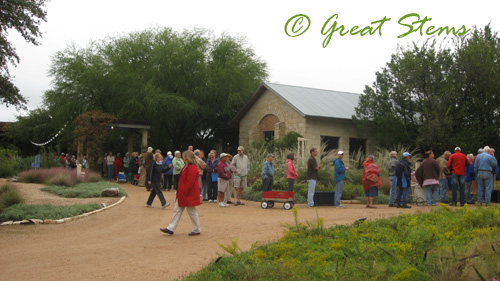
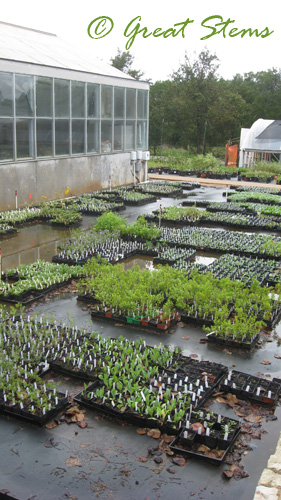 Up near the front of the line, my husband and I chatted with our friendly line neighbors.
Up near the front of the line, my husband and I chatted with our friendly line neighbors. Of course, when the ribbon was cut and the sale actually opened, we all said something along the lines of “It was so very nice talking to you! Now stay away from my plants!” (And at this point I stopped taking pictures, because the mad rush to find all coveted plants began. In fact, if you couldn’t tell from the images — these are from my pocket camera instead of my regular camera. I had to make sure I wasn’t overburdened when plants were at stake! Yes, at first it can seem like a frenzy, particularly for the rarer species. I didn’t start taking pictures again until all our plants were chosen, and by then many buyers had already cleared out, so this crowd looks small compared to the earlier blockade of people all trying to get their carts through the aisles while collecting as many plants on their list that they could).
Of course, when the ribbon was cut and the sale actually opened, we all said something along the lines of “It was so very nice talking to you! Now stay away from my plants!” (And at this point I stopped taking pictures, because the mad rush to find all coveted plants began. In fact, if you couldn’t tell from the images — these are from my pocket camera instead of my regular camera. I had to make sure I wasn’t overburdened when plants were at stake! Yes, at first it can seem like a frenzy, particularly for the rarer species. I didn’t start taking pictures again until all our plants were chosen, and by then many buyers had already cleared out, so this crowd looks small compared to the earlier blockade of people all trying to get their carts through the aisles while collecting as many plants on their list that they could).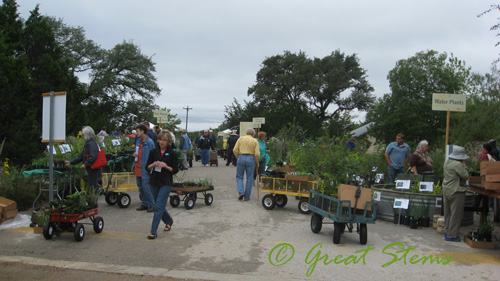
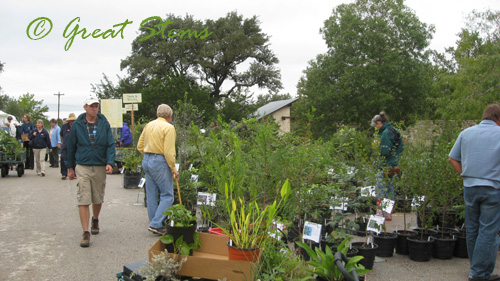

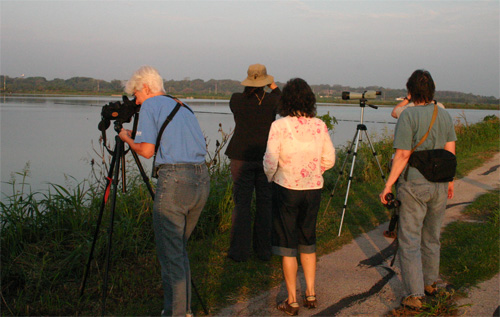 Hornsby Bend is an area along a “bend” of the Colorado River, southeast of Austin, Texas, near the airport. Once home to dense forests and thickets, a man named Reuben Hornsby settled there in 1832, clearing the land for agricultural uses. Today it is home to the
Hornsby Bend is an area along a “bend” of the Colorado River, southeast of Austin, Texas, near the airport. Once home to dense forests and thickets, a man named Reuben Hornsby settled there in 1832, clearing the land for agricultural uses. Today it is home to the 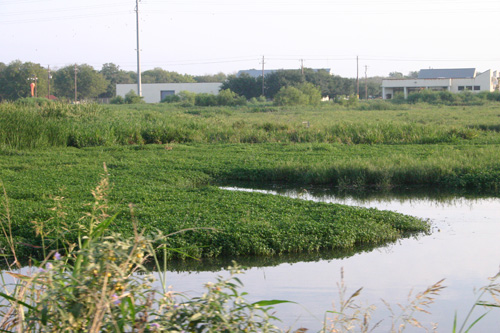 But Hornsby Bend is so much more — 1,200 acres of marshes, woodlands, pastures, and riparian (river) areas. Because of the incredible biodiversity along the food chain and its multiple habitats, it has become known nationally as one of the best birdwatching sites in Texas, especially during times of migration. More than 360 species of birds have been sighted at Hornsby Bend. Migratory shorebirds, wading birds, and landbirds, some from the Arctic or from the southern tip of South America, stop at the ponds of Hornsby Bend as they travel to and from their winter habitats.
But Hornsby Bend is so much more — 1,200 acres of marshes, woodlands, pastures, and riparian (river) areas. Because of the incredible biodiversity along the food chain and its multiple habitats, it has become known nationally as one of the best birdwatching sites in Texas, especially during times of migration. More than 360 species of birds have been sighted at Hornsby Bend. Migratory shorebirds, wading birds, and landbirds, some from the Arctic or from the southern tip of South America, stop at the ponds of Hornsby Bend as they travel to and from their winter habitats.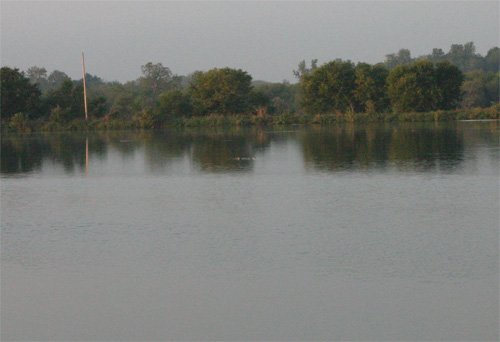
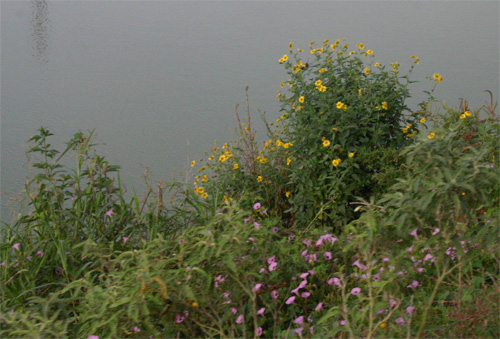
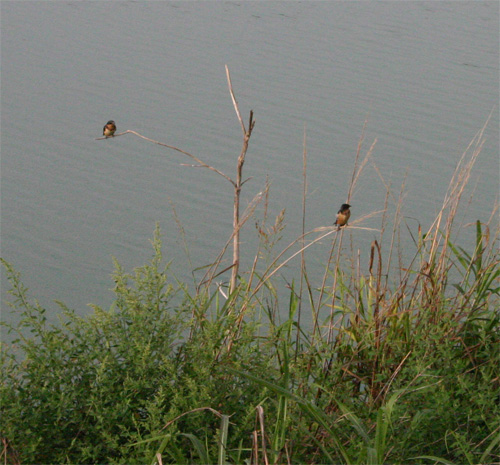 Near the wet grounds by the compost, many least sandpipers and other species scooted about for insects.
Near the wet grounds by the compost, many least sandpipers and other species scooted about for insects.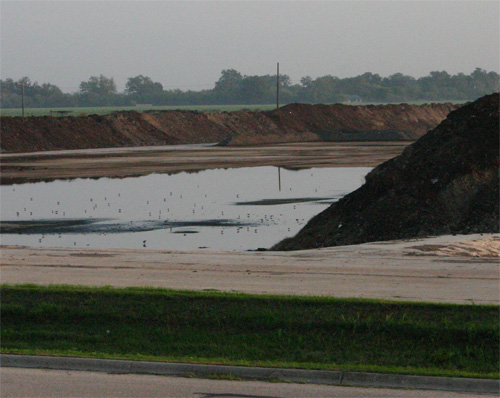 And humans studied them from afar.
And humans studied them from afar.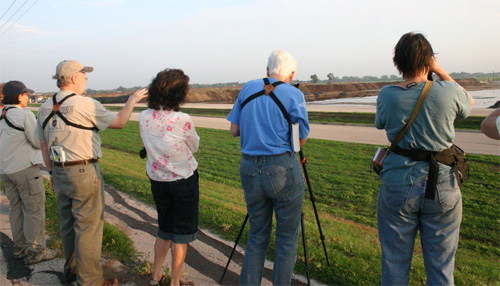 The wooded areas along the river provided opportunities to see tree-perching birds. A quiet walk along the paths allowed us to listen to the beautiful songs of many a bird, including the white-eyed vireo.
The wooded areas along the river provided opportunities to see tree-perching birds. A quiet walk along the paths allowed us to listen to the beautiful songs of many a bird, including the white-eyed vireo. 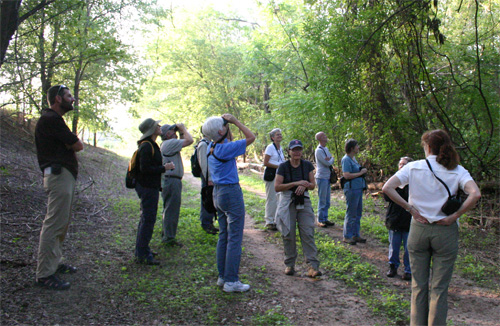 Another treatment area, these long greenhouses will also provide winter shelter to area birds. A red-shouldered hawk reportedly has hunted in there, in fact.
Another treatment area, these long greenhouses will also provide winter shelter to area birds. A red-shouldered hawk reportedly has hunted in there, in fact.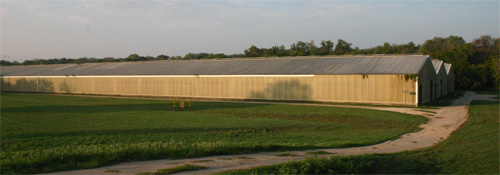
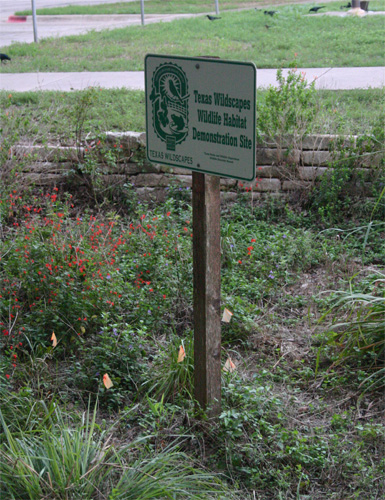 And there are purple martins, too, though they are absent in September.
And there are purple martins, too, though they are absent in September.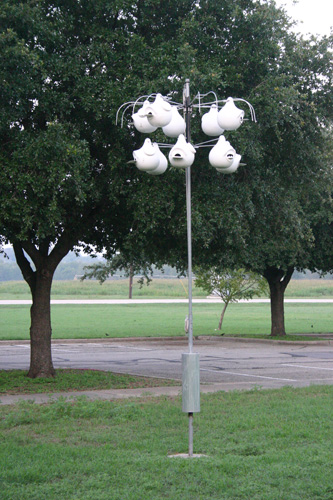
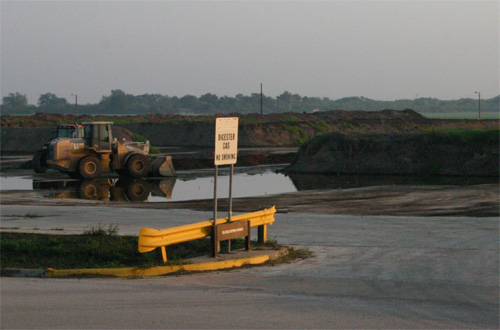 Back at the main building, the Habitat Steward Trainees listened to three speakers. The knowledge I gained this day was tremendous, from the history of the soil in the Austin area to the how’s and whys of organic matter, and from butterflies of Central Texas to urban wildlife, such as coyotes and raccoons. A great day, and a great place to visit.
Back at the main building, the Habitat Steward Trainees listened to three speakers. The knowledge I gained this day was tremendous, from the history of the soil in the Austin area to the how’s and whys of organic matter, and from butterflies of Central Texas to urban wildlife, such as coyotes and raccoons. A great day, and a great place to visit.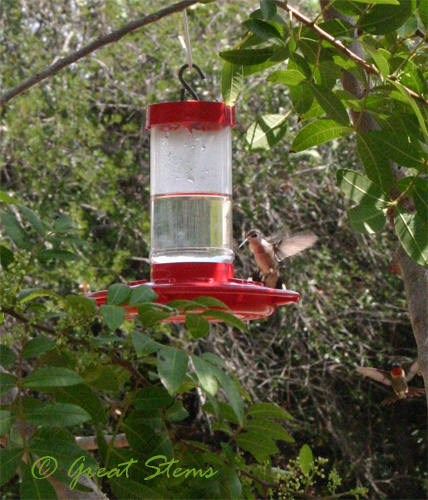

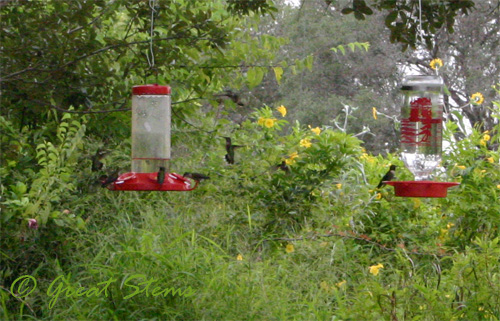 Rockport isn’t just about hummingbirds — hundreds of species of birds are year-round residents or migratory passers-through, and birdwatchers excitedly converge with binoculars in hand to enjoy the sheer numbers and to hopefully catch a glimpse of a rare species. At any given home on the hummingbird tours, there might be as many as 100 or more hummingbirds zooming about the feeders.
Rockport isn’t just about hummingbirds — hundreds of species of birds are year-round residents or migratory passers-through, and birdwatchers excitedly converge with binoculars in hand to enjoy the sheer numbers and to hopefully catch a glimpse of a rare species. At any given home on the hummingbird tours, there might be as many as 100 or more hummingbirds zooming about the feeders.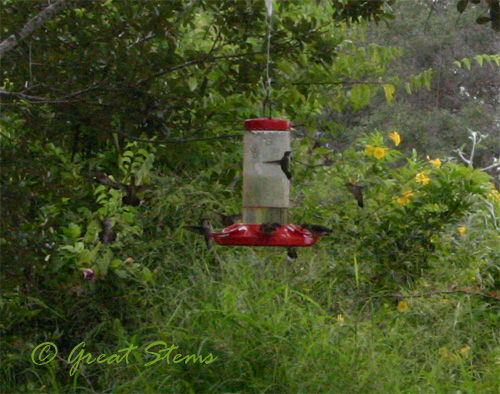
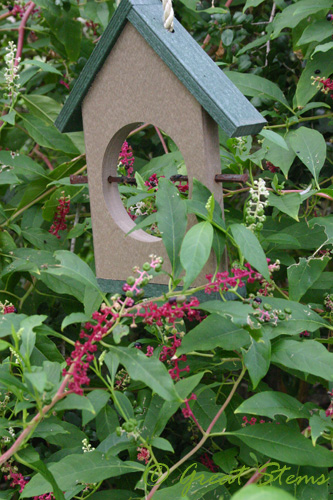
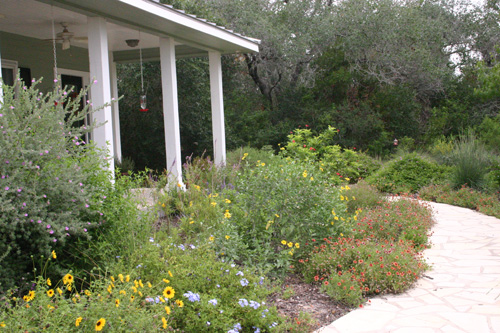
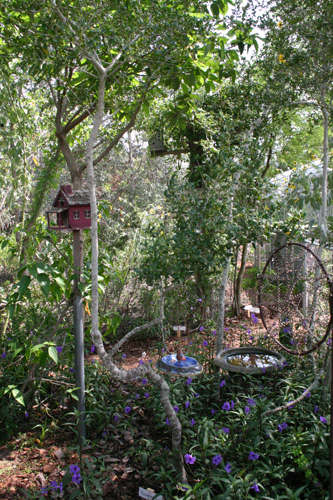
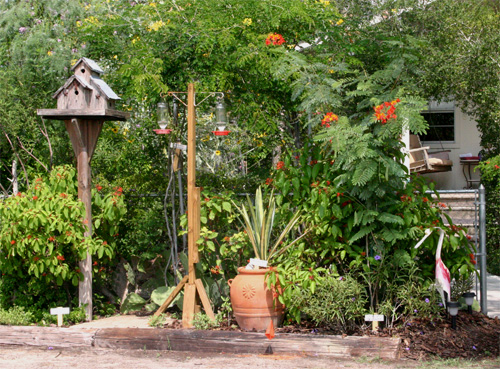 But there were a variety of landscapes on the tour, and there was even a school garden, planted and maintained by students and teachers.
But there were a variety of landscapes on the tour, and there was even a school garden, planted and maintained by students and teachers. 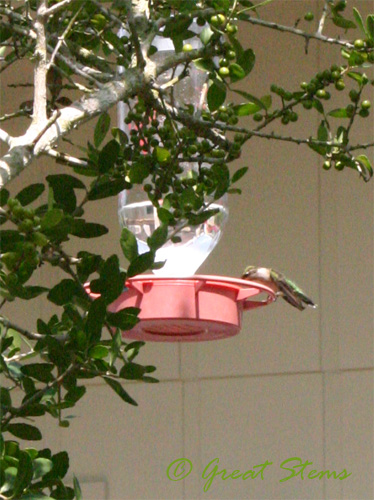 It was thoroughly entertaining watching the antics of the territorial hummingbirds. Their behavior is different at migration time — because the birds need to build up their energy stores, there is more willingness for many, but not all, of the birds to share a feeder from time to time. Despite the many feeders about a yard, the hummingbirds might swarm a particular feeder, as if they think that because others are that feeder, it must be good food. But territoriality is hard to resist sometimes, especially for the males. The vibrant color of the throats of the male birds was impressive, though Sheri said that these feathers are post-mating season, and thus less vibrant than at other times. Pretty cool.
It was thoroughly entertaining watching the antics of the territorial hummingbirds. Their behavior is different at migration time — because the birds need to build up their energy stores, there is more willingness for many, but not all, of the birds to share a feeder from time to time. Despite the many feeders about a yard, the hummingbirds might swarm a particular feeder, as if they think that because others are that feeder, it must be good food. But territoriality is hard to resist sometimes, especially for the males. The vibrant color of the throats of the male birds was impressive, though Sheri said that these feathers are post-mating season, and thus less vibrant than at other times. Pretty cool. 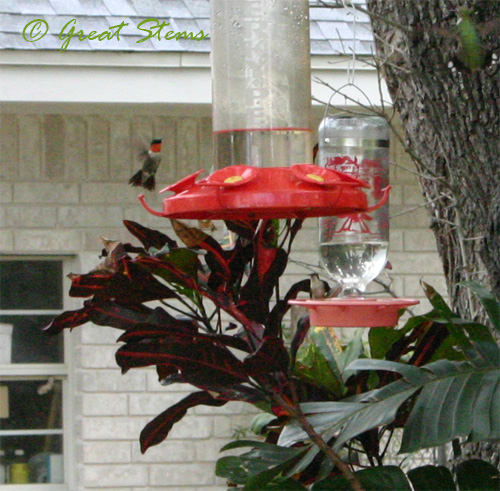
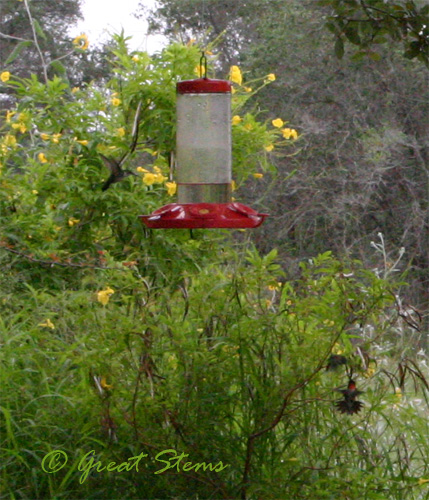 The majority of the hummingbirds that pass through Rockport are ruby-throated hummingbirds, but several species have been sighted, and in all more than 500 species of birds have been documented.
The majority of the hummingbirds that pass through Rockport are ruby-throated hummingbirds, but several species have been sighted, and in all more than 500 species of birds have been documented.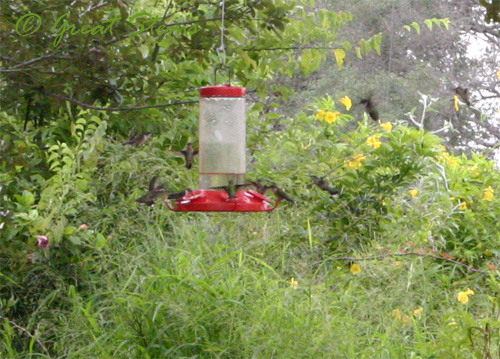 There was another creature that threatened to bring downfall to the festival this year, the heat-seeking, blood-sucking, mass-attacking mosquito. It was unbelievable the numbers of mosquitoes everywhere, and they swarmed every person by the hundreds. The mosquitoes were so bad at the very first house we stopped at that, that our hummingbird viewing would have come to an end before it started if we hadn’t decided to just go ahead and use some loaned icky chemical spray that I would never touch at home. But we were having to do a ridiculous and constant “Mosquito-Slapping Dance” until we finally used the spray, and if a green person is going to that extreme, you know it’s bad.
There was another creature that threatened to bring downfall to the festival this year, the heat-seeking, blood-sucking, mass-attacking mosquito. It was unbelievable the numbers of mosquitoes everywhere, and they swarmed every person by the hundreds. The mosquitoes were so bad at the very first house we stopped at that, that our hummingbird viewing would have come to an end before it started if we hadn’t decided to just go ahead and use some loaned icky chemical spray that I would never touch at home. But we were having to do a ridiculous and constant “Mosquito-Slapping Dance” until we finally used the spray, and if a green person is going to that extreme, you know it’s bad. 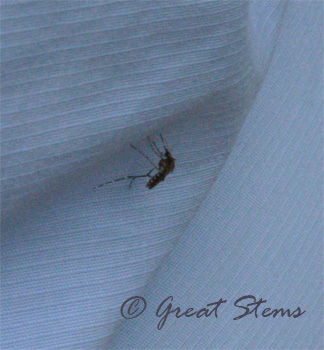
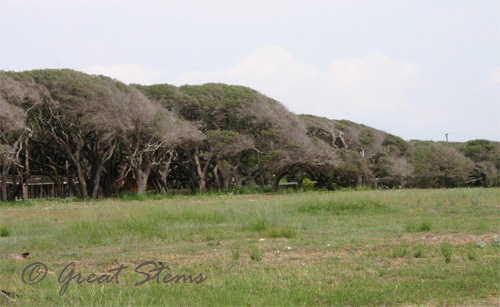
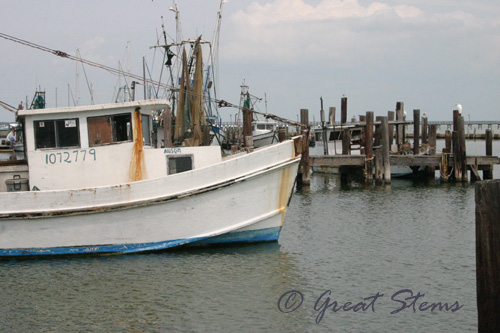 Outside of Moon Dog, where we had lunch, a lone pelican rested peacefully. It was quite the contrast to the zooming hummingbirds at the inland homes.
Outside of Moon Dog, where we had lunch, a lone pelican rested peacefully. It was quite the contrast to the zooming hummingbirds at the inland homes. 